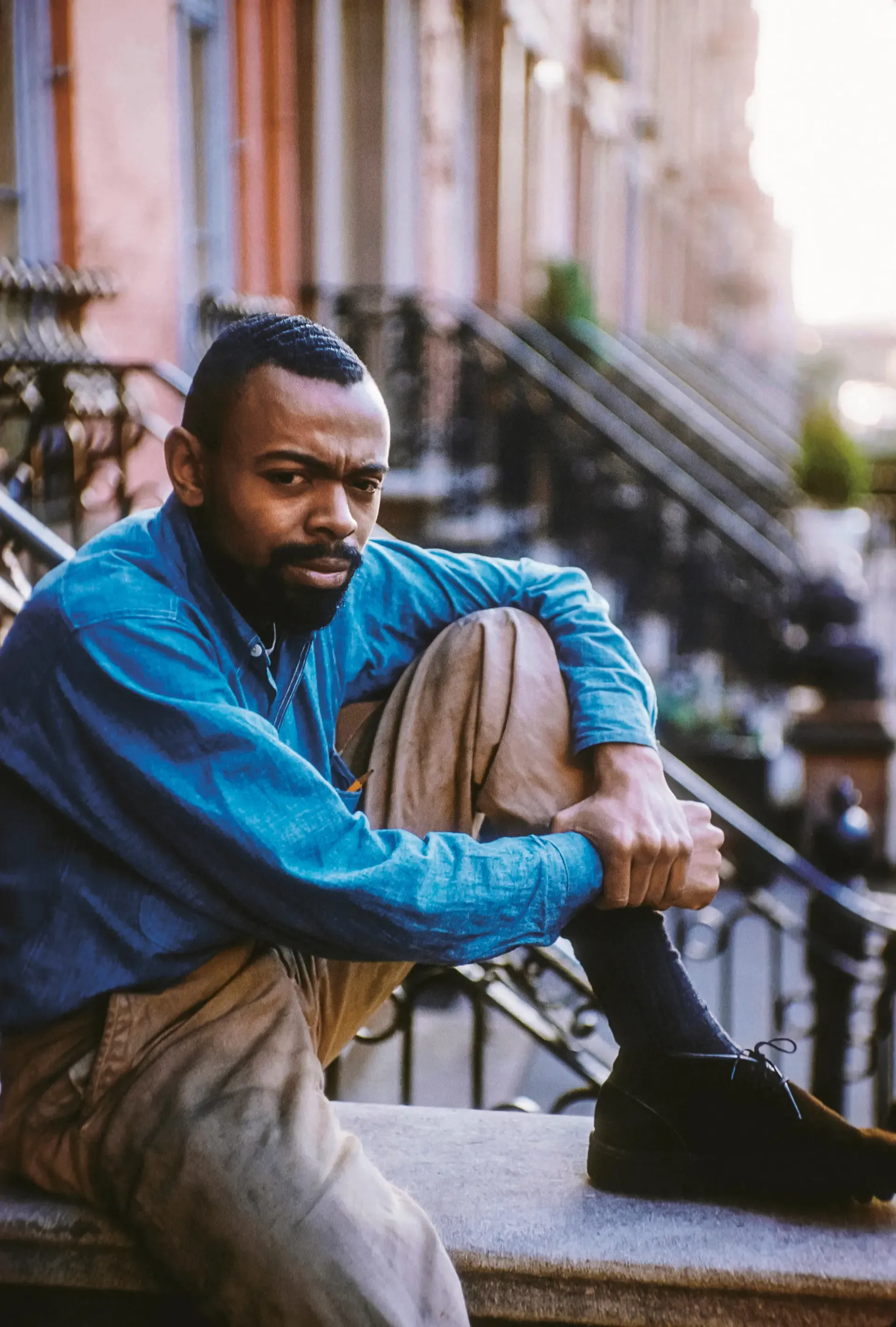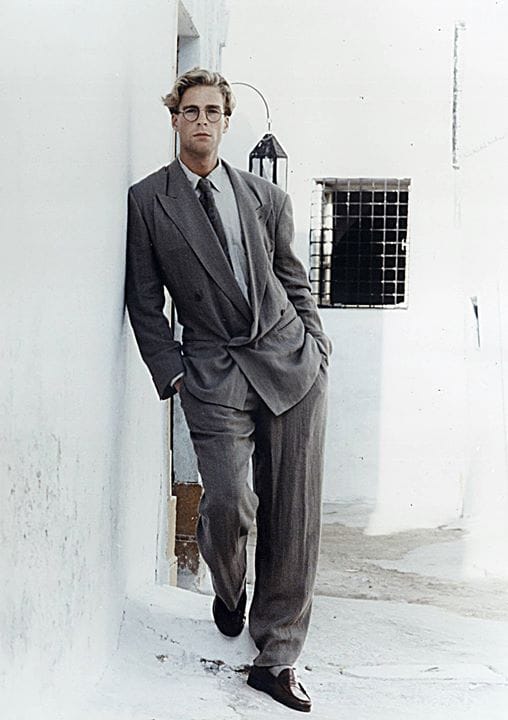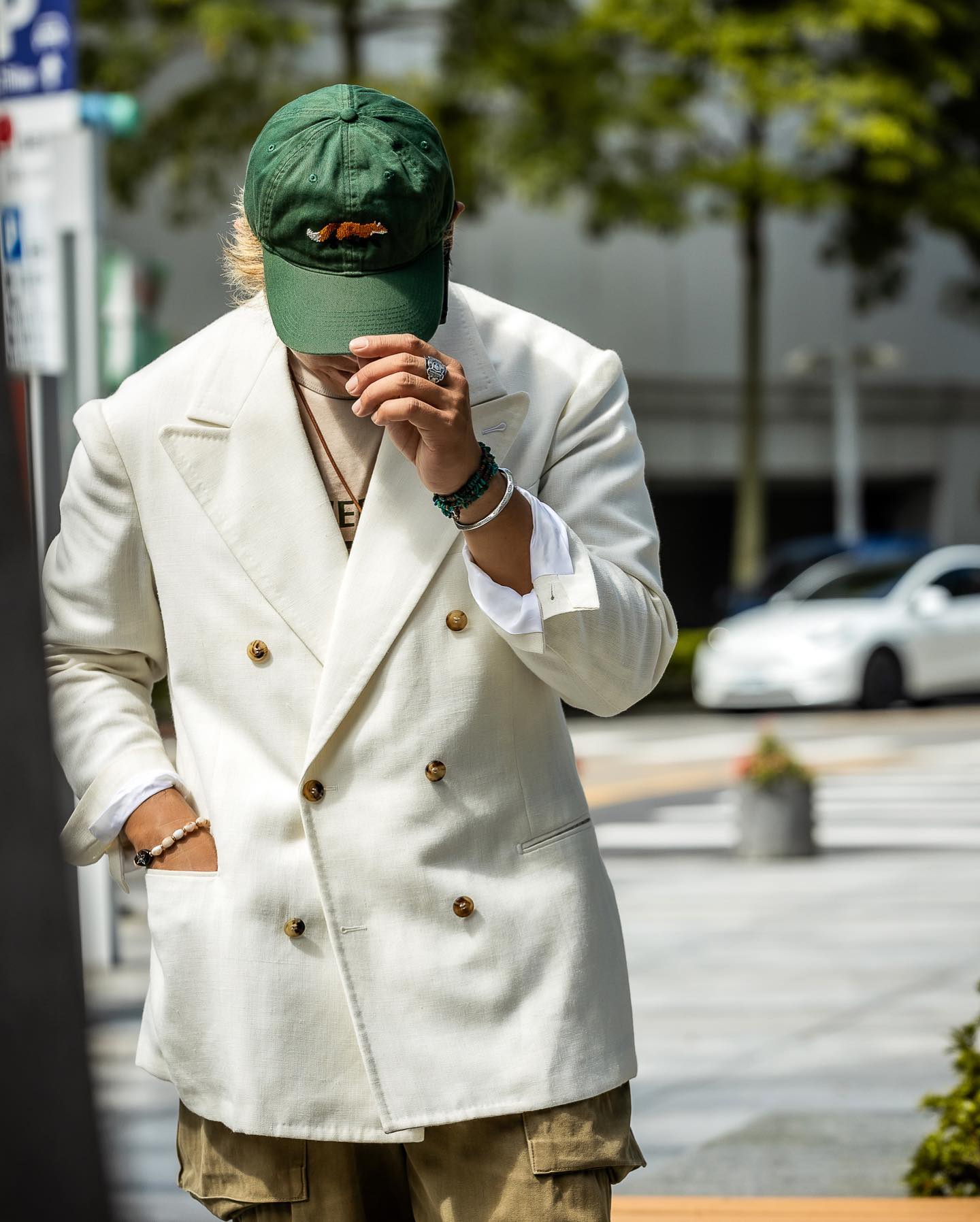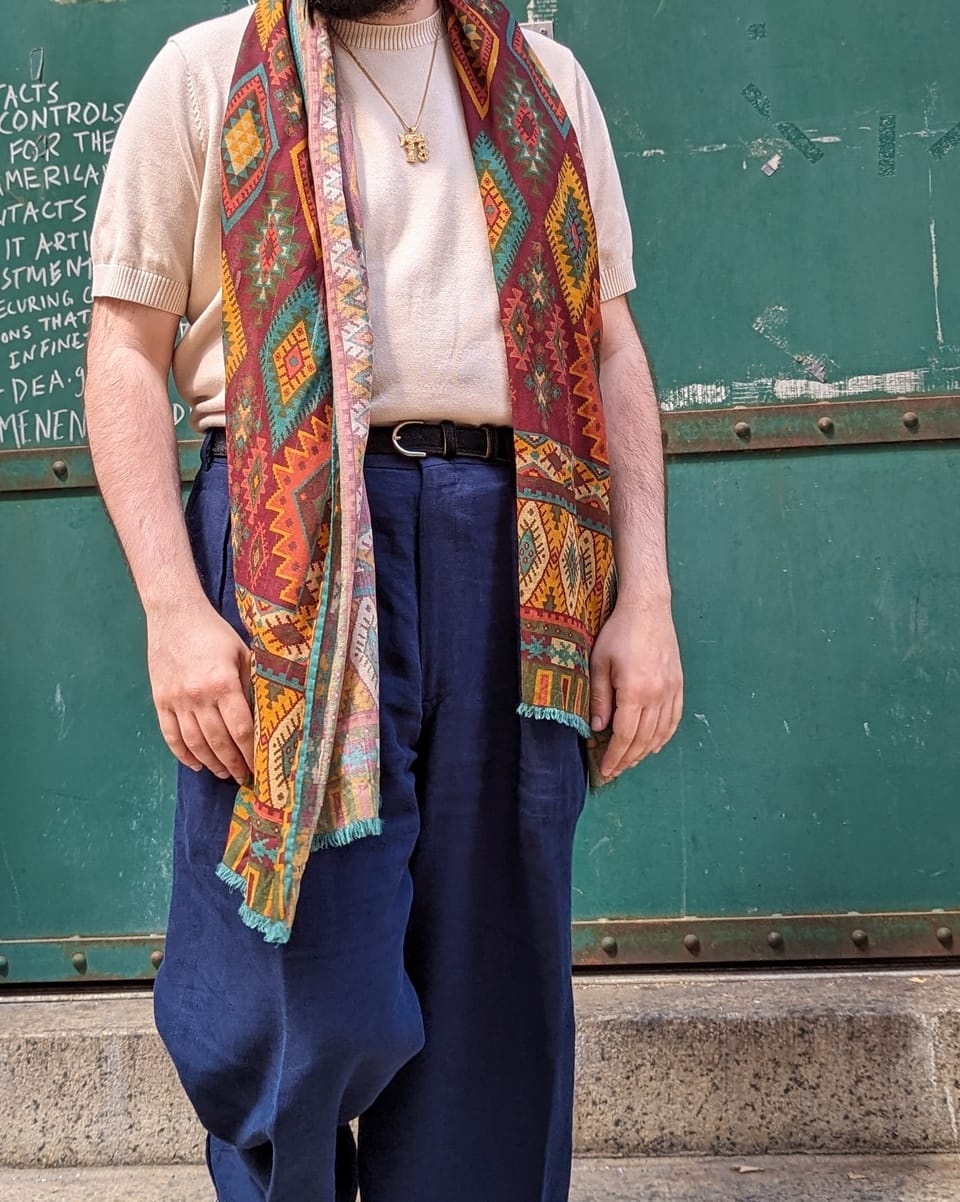A Conversation with Buzz Tang of The Anthology
I recently had a chance to sit down with Buzz Tang of The Anthology. What follows is a deep dive into not only what makes great clothing, but the spirit of a modern bespoke brand.
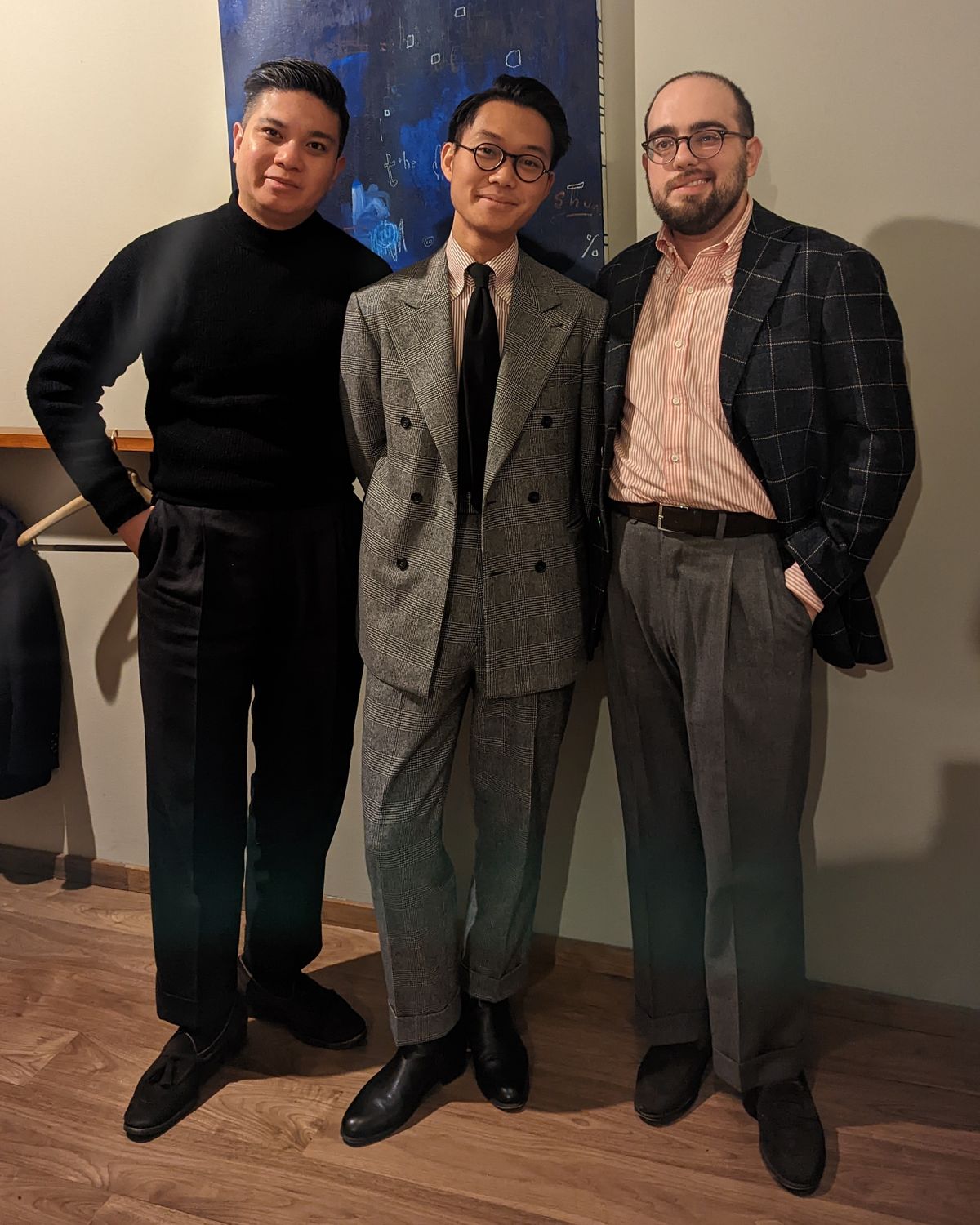
A little while back, I had a chance to speak with Buzz Tang, co-founder of The Anthology. In case you weren't aware, The Anthology is a bespoke tailoring house with a combination of modern and classic perspectives, and an array of unique casual pieces with classic twists.
I tried on a few of their ready-to-wear garments (everything is great) and spoke to the team (Buzz, Co-founder Andy Chong, and Ed) before sitting down and asking Buzz the questions I had prepared. And while I was excited to be there, interviewing a man I had been following online, it really felt like a natural conversation. Buzz speaks freely about the brand's design process, experiences with clients, sources of inspiration, and even some upcoming pieces. What follows is a deep dive into not only what makes great clothing, but the spirit of a modern bespoke brand.
We spoke for a bit before I started recording, so I dive in at the part that feels right, and maintain our casual, conversational tone throughout. Enjoy.
The Interview.
Daniel Hakimi: I really want to talk about casual perspectives, but I definitely want to start with proper tailoring, suit and tie. I want to get a perspective on how you develop your cuts, and where where the inspiration came from. There seems to be some 30s or 40s inspiration, some "Esquire Man," but there's definitely also a modern take on it, and I want to get your an idea of the design process.
Buzz Tang: It goes way back to the name itself. "Anthology," a library, a curation of fine things. Not meaning like, you know, we're not a multi-brand store, we're not The Armoury, we're not trying to get, you know, Maker A, Maker B, Maker C. Everything's made in-house by ourselves. Our idea of curation is: we curate, and we do research on, multiple facets; basically explore different realms of menswear, or even lifestyle in general, depicting, for example, streetwear—well, not exactly streetwear, not quite there yet, although you may argue, like the Casentino jacket, that blouson is a little more street, you can actually go down to soho...
DH: Oh yeah, I can definitely see certain streetwear guys I know wearing something like that.
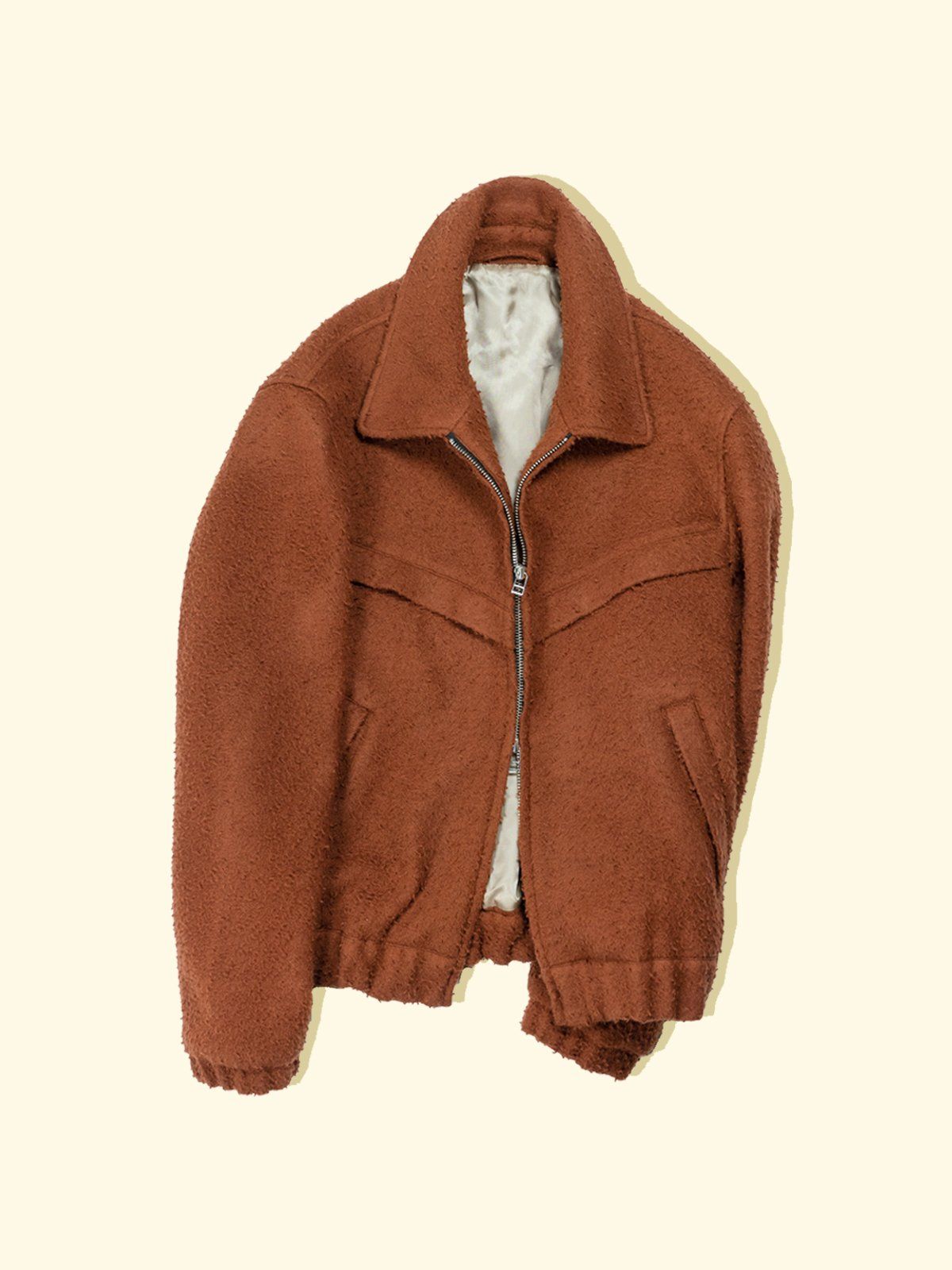
BT: Yeah, so we're getting there as well. We're slowly exploring different identities. As we always say, we love amplifying a personal identity to someone. So, it's quite open-minded. It's a little bit of an open book as well.
Our casual identity... I think we have a little bit of that sort of like golden era inspiration, in the sense that, when you actually look at the shoulder, at our signature roping, there is a little bit of natural drooping, and then kind of pops back up again. Those tiny things... It's that combination. Both the old and modern. It's old school because it still has a little bit of that sort of roping but at the same time it's really soft, it's padless. I think it's the nuance that we have in our design that makes the Anthology garment a modern garment. Especially with the way we present it as well.
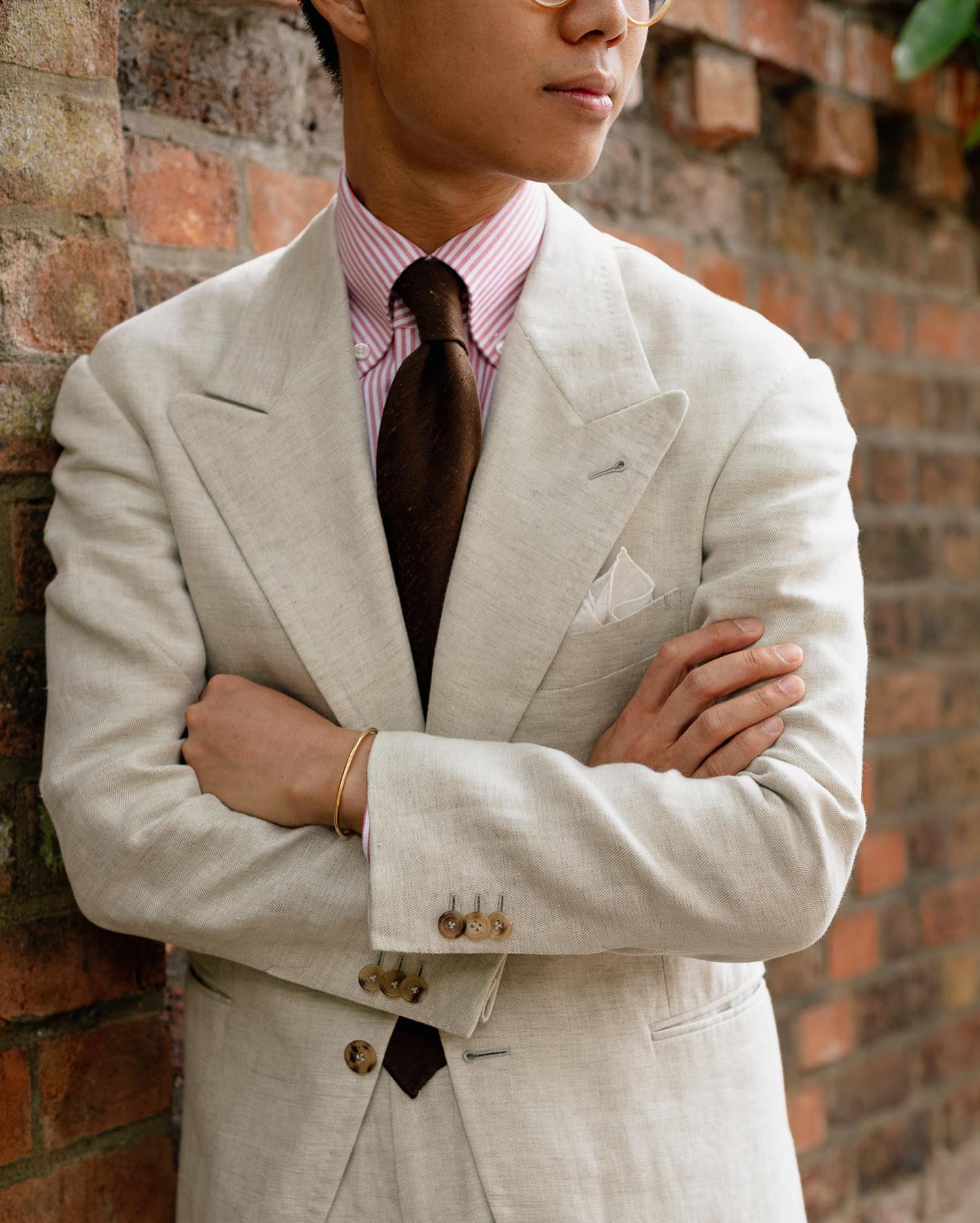
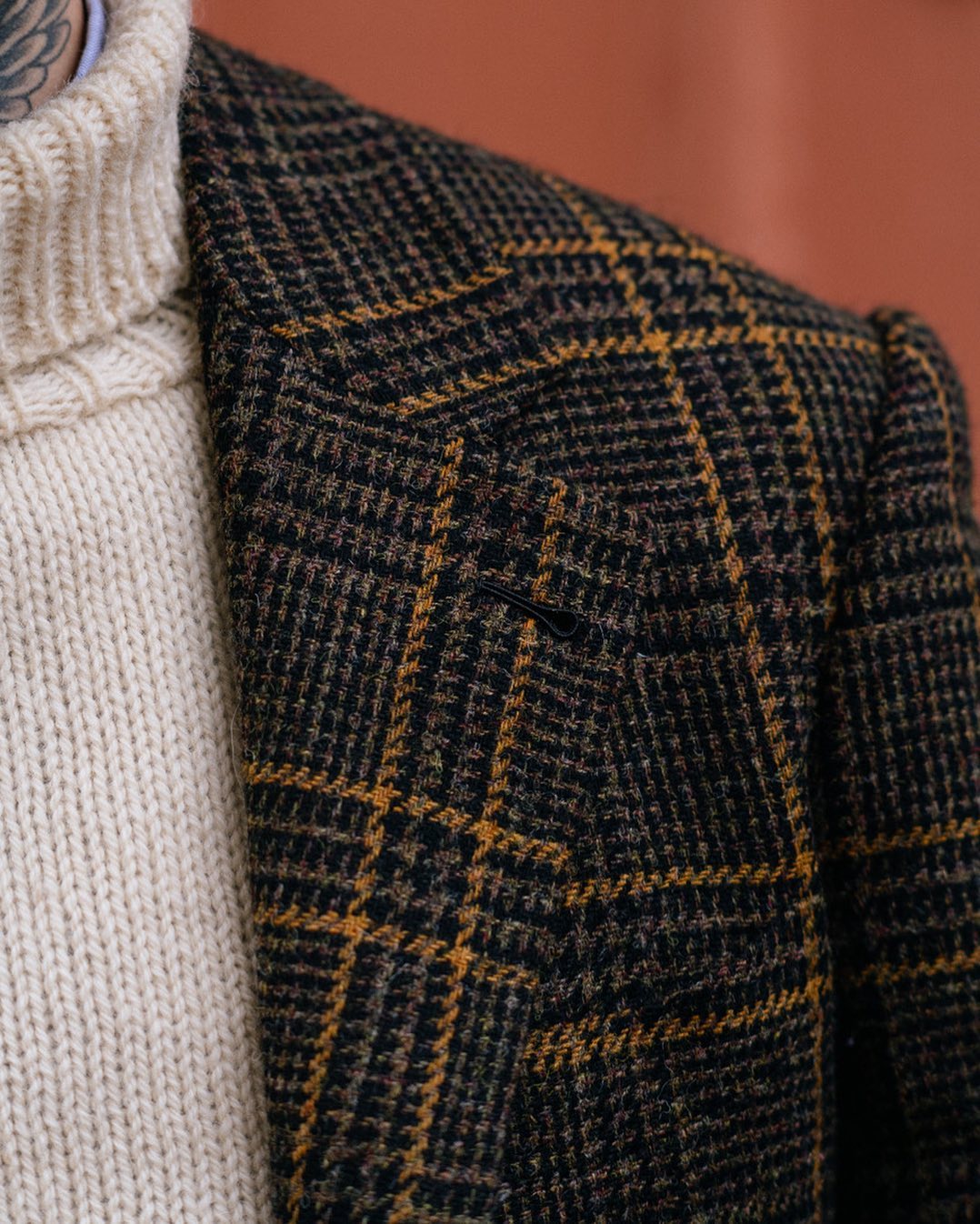
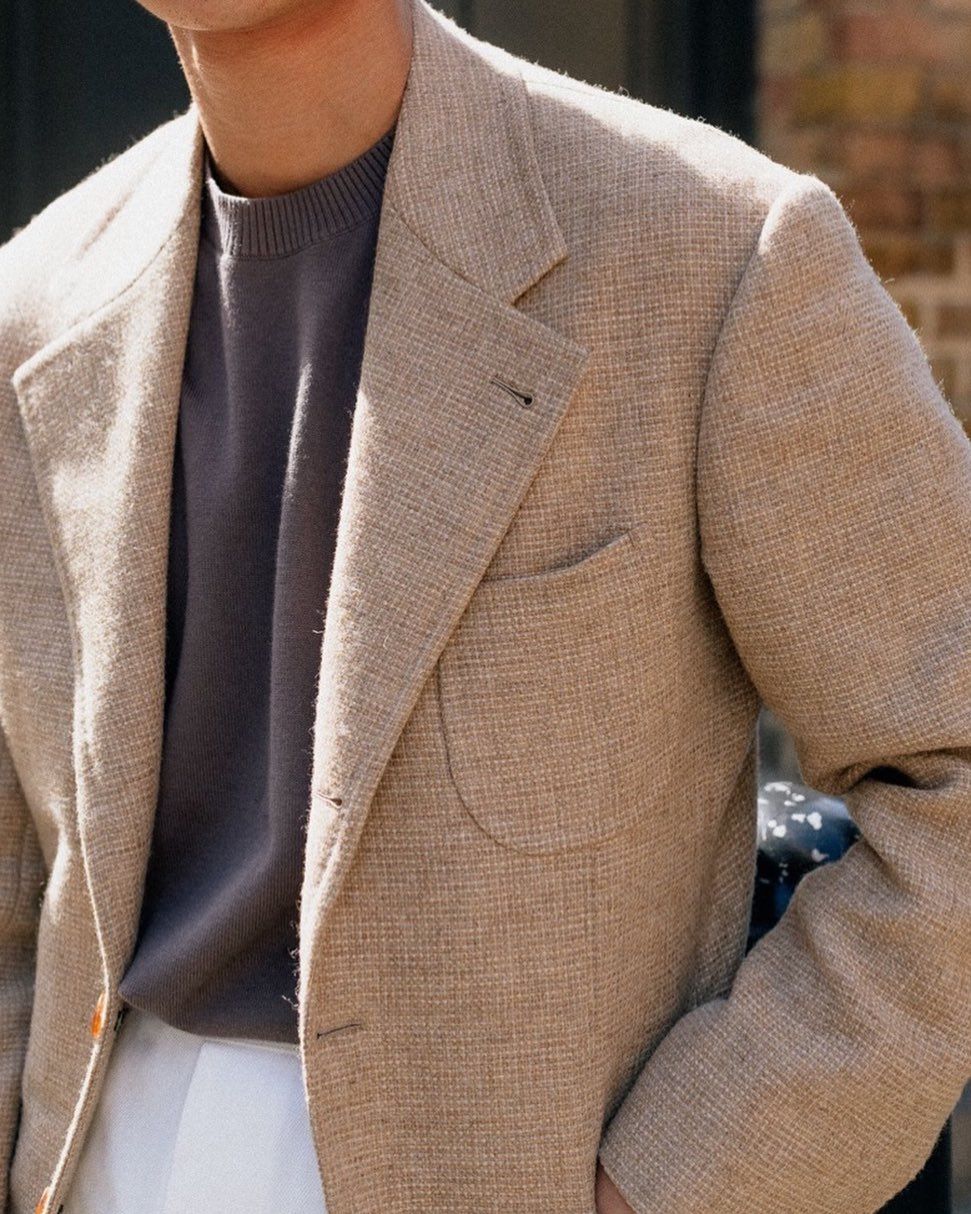
Look at those shoulders!
DH: Right. So, I do also want to talk to you about styling because I feel like, on your on your main Instagram accounts (@theanthlogy, @theanthology_tw), there's a lot of ties, there's a lot of woven shirts. It's a lot of proper tailored, classic outfits—and and obviously, you know, the blouson too, the knit t-shirts too. But then I see a lot of Anthologists—particularly, there's there's a lot of guys who will wear, say, your suits with graphic tees, and the like.
Do you think there's anything particular about your cut or your brand identity that makes it more available for for experimenting in those ways, or for, you know, dressing down in those ways?
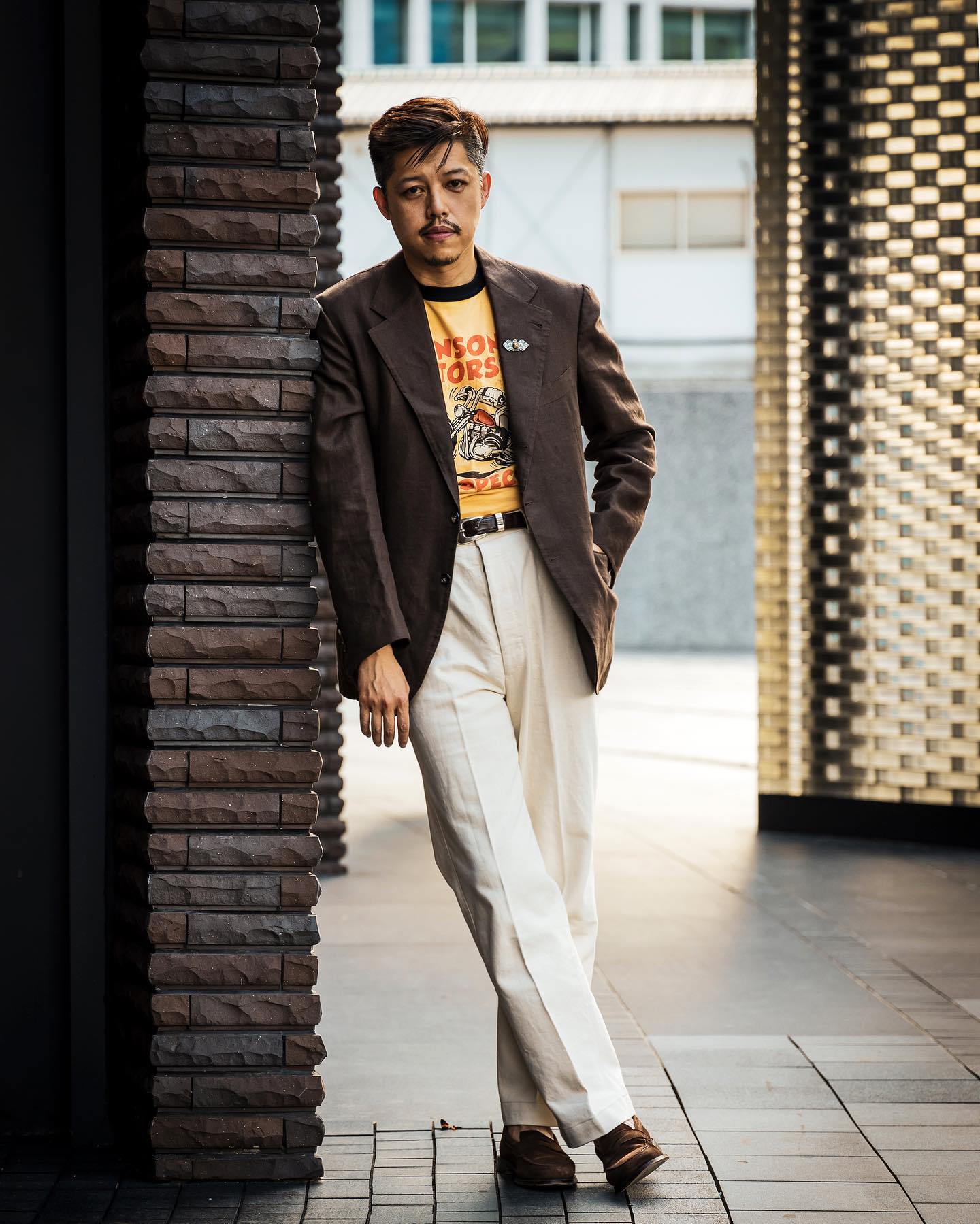
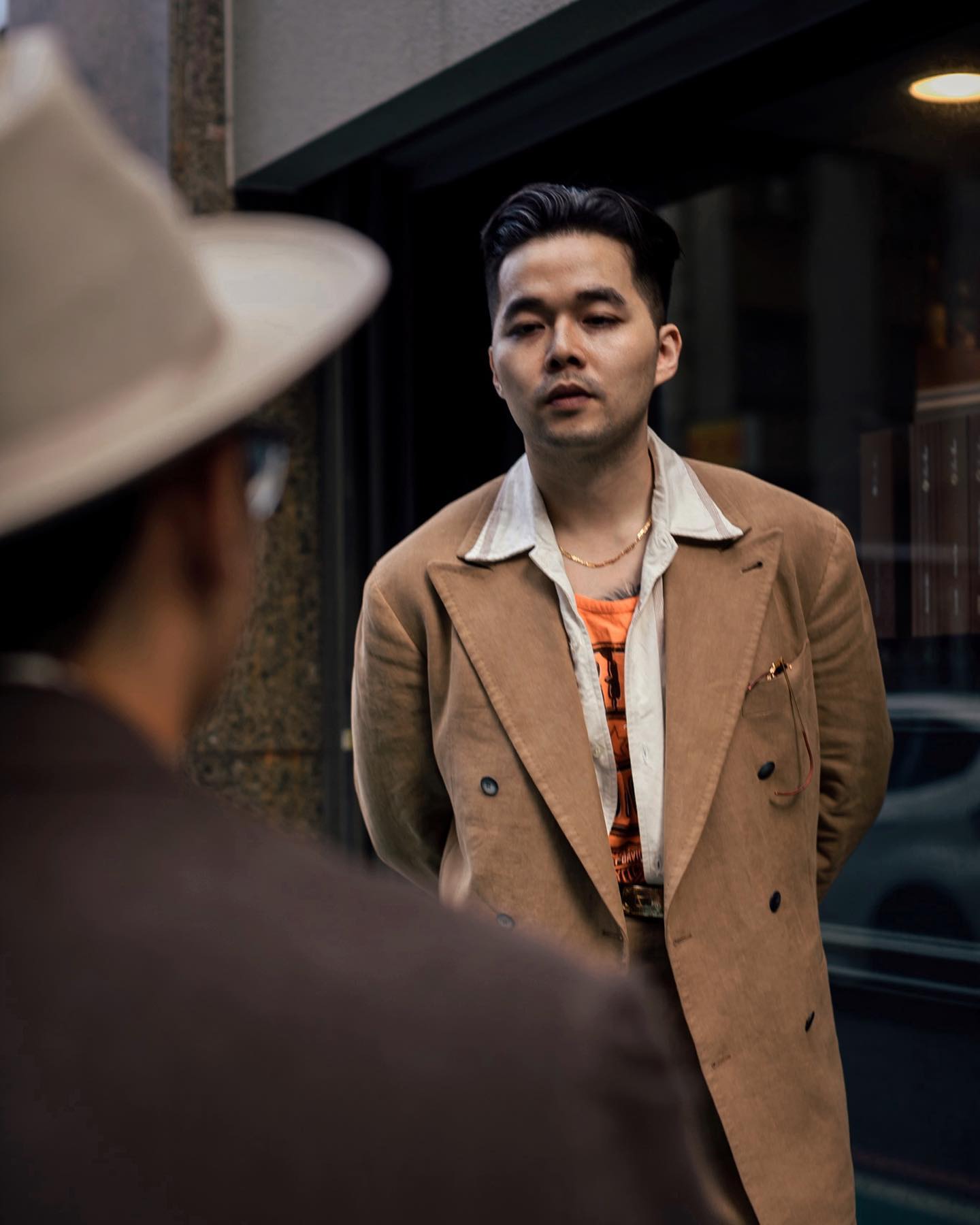
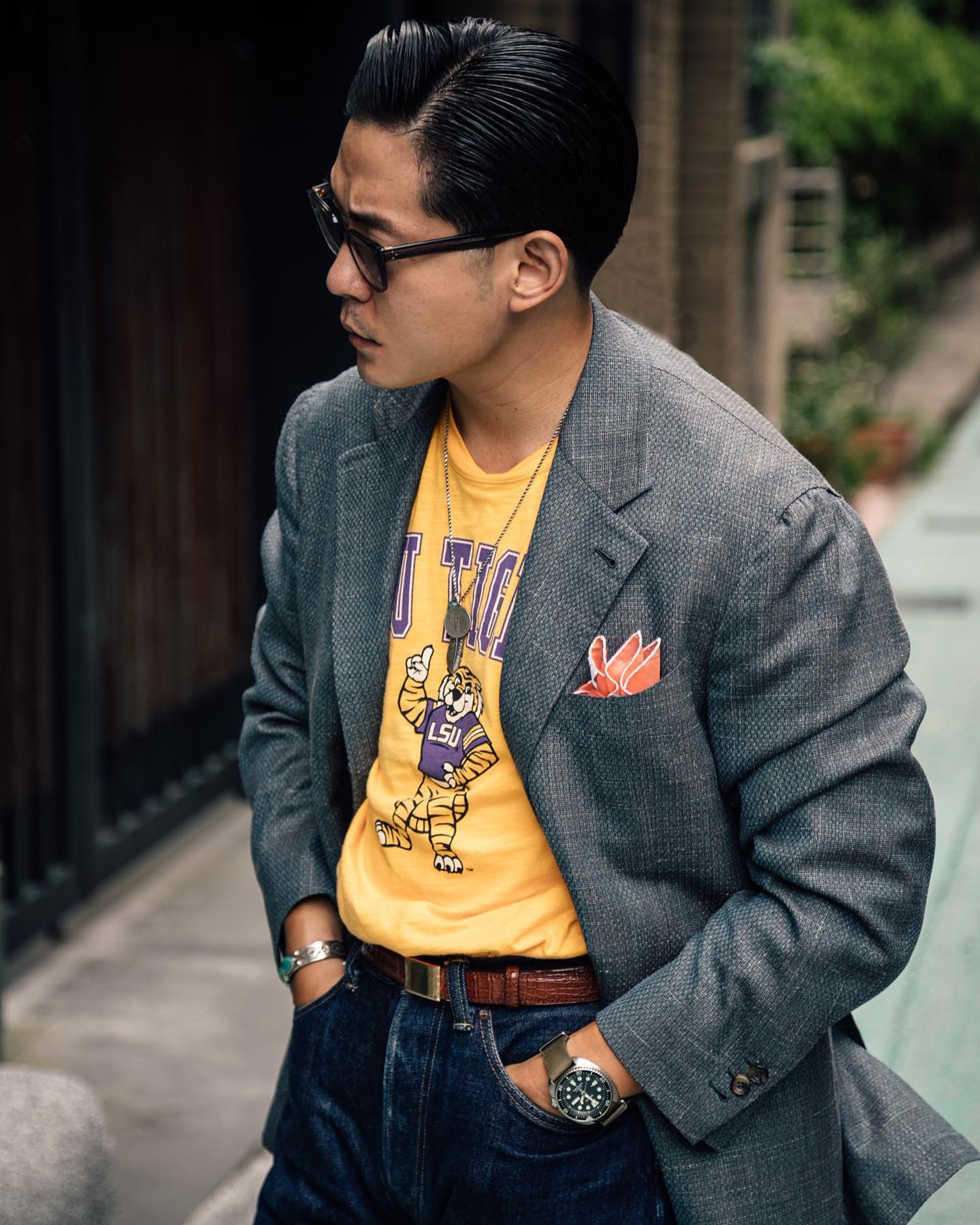
Aaron Hu, @hsinhan_seatheworld, and Robert Weng, wearing The Anthlogy's jackets with colorful graphic tees.
BT: Hmm, I could certainly... The house style itself. The versatility. What this garment as a base, can offer, starting from the shoulders, to the lapels, to the specific gorge height. The curvature of the garment—I think that distinctively differentiates our garment from, for example, a very traditional English garment, where everything's little edgier as well as squarer, or maybe a little more triangular, a little more geometrical, whereas ours is more rounded, I think with that balance, it gives a slightly friendlier profile. A little bit more pared down. Even when you have it done as a suit you don't always think it would be a very formal garment. It's formal enough. It would actually suffice for, you know, for work. You can actually wear it, put on a tie the way we would wear them.
DH: Absolutely. Yeah. Again, it has those classic inspirations, the features of thoe 30s and 40s cuts, but it straddles line beautifully. And then obviously, your double-breasted cut, it has a little more of those angular features, those peak lapels, even some peak lapels on single breasted jackets. But yeah, maybe just the softness, in general, manages to straddle that line.
Let me talk to you about fabric. You use a lot of tweed, you get deadstock fabrics and vintage fabrics, but you also developed that beautiful Harris Tweed with Jamie Ferguson. And the Fab Gorjian gray and yellow fabric, I love that one. I love the fabric you're wearing now. The Casentino...
BT In fact, we had something very similar back in the day, our first batch of ready to wear, which was actually our own development with a very with a very renowned Scottish mill. It was a shaggy dog jacket. It kind of resonates a little there, there's a certain resemblance to a Casentino cloth. Like, it still kind of had this sort of... shag fuzziness the fuzziness. It kind of looks like a sheep.
DH: Is is that the cream jacket from... wasn't that a couple of years ago?
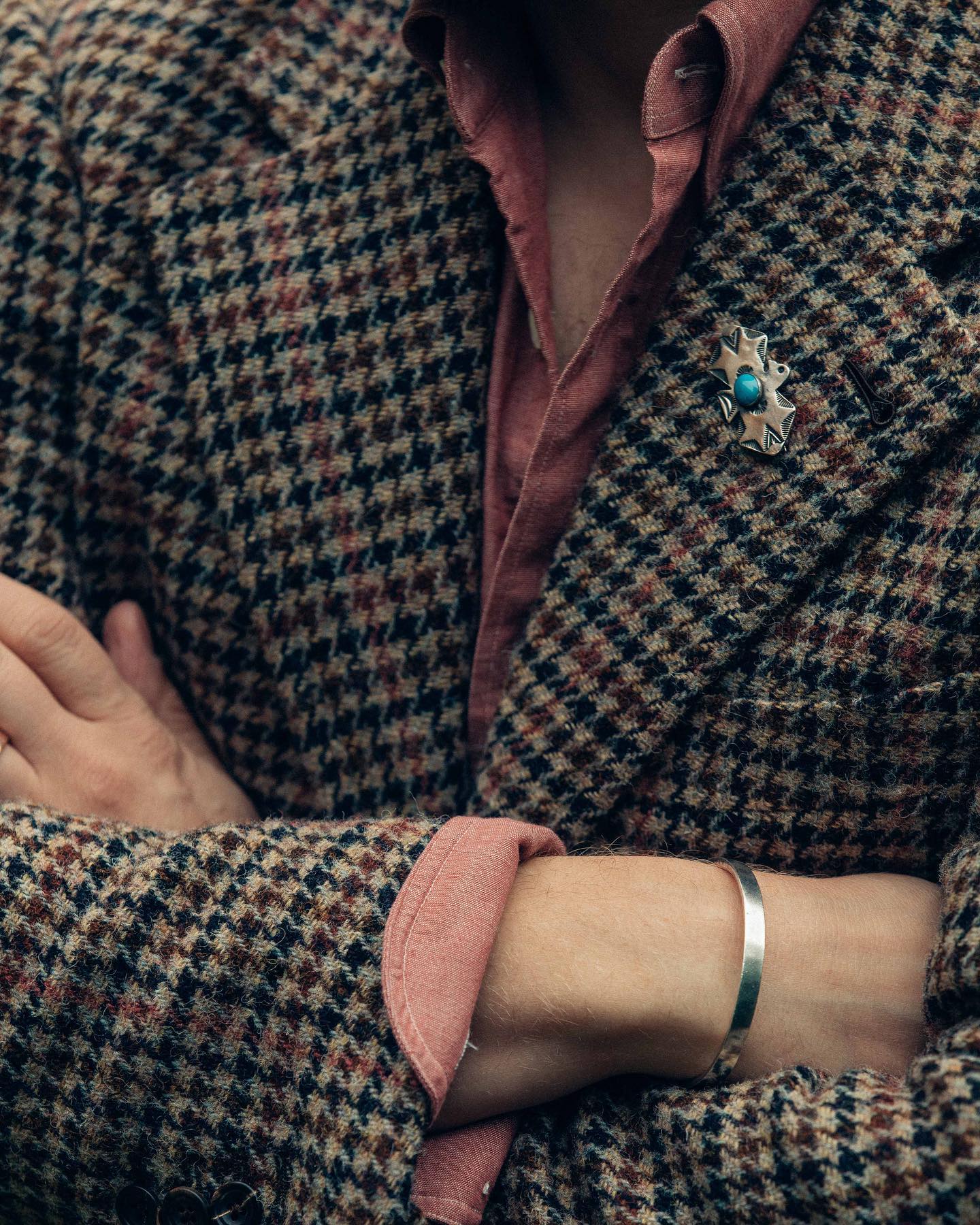
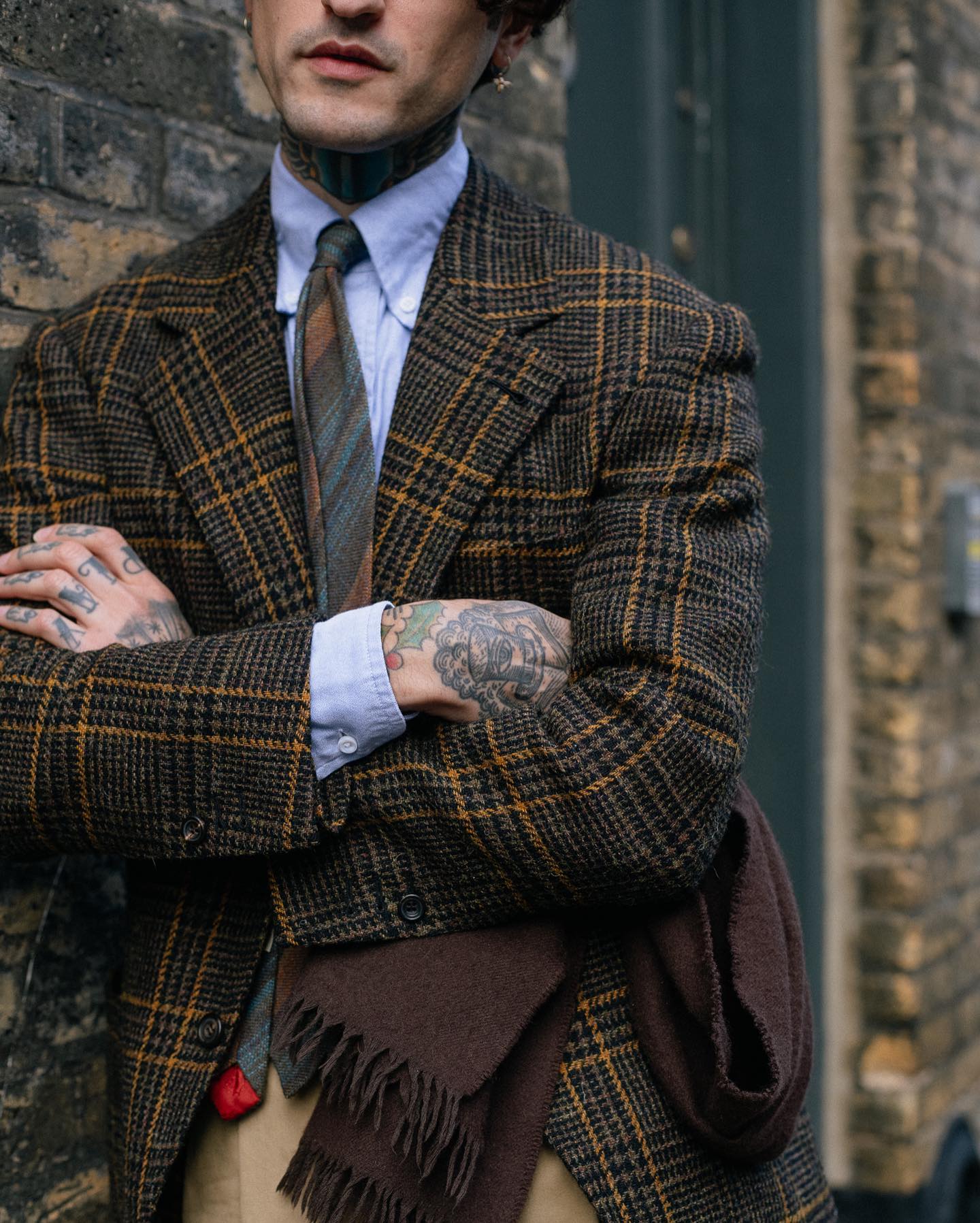
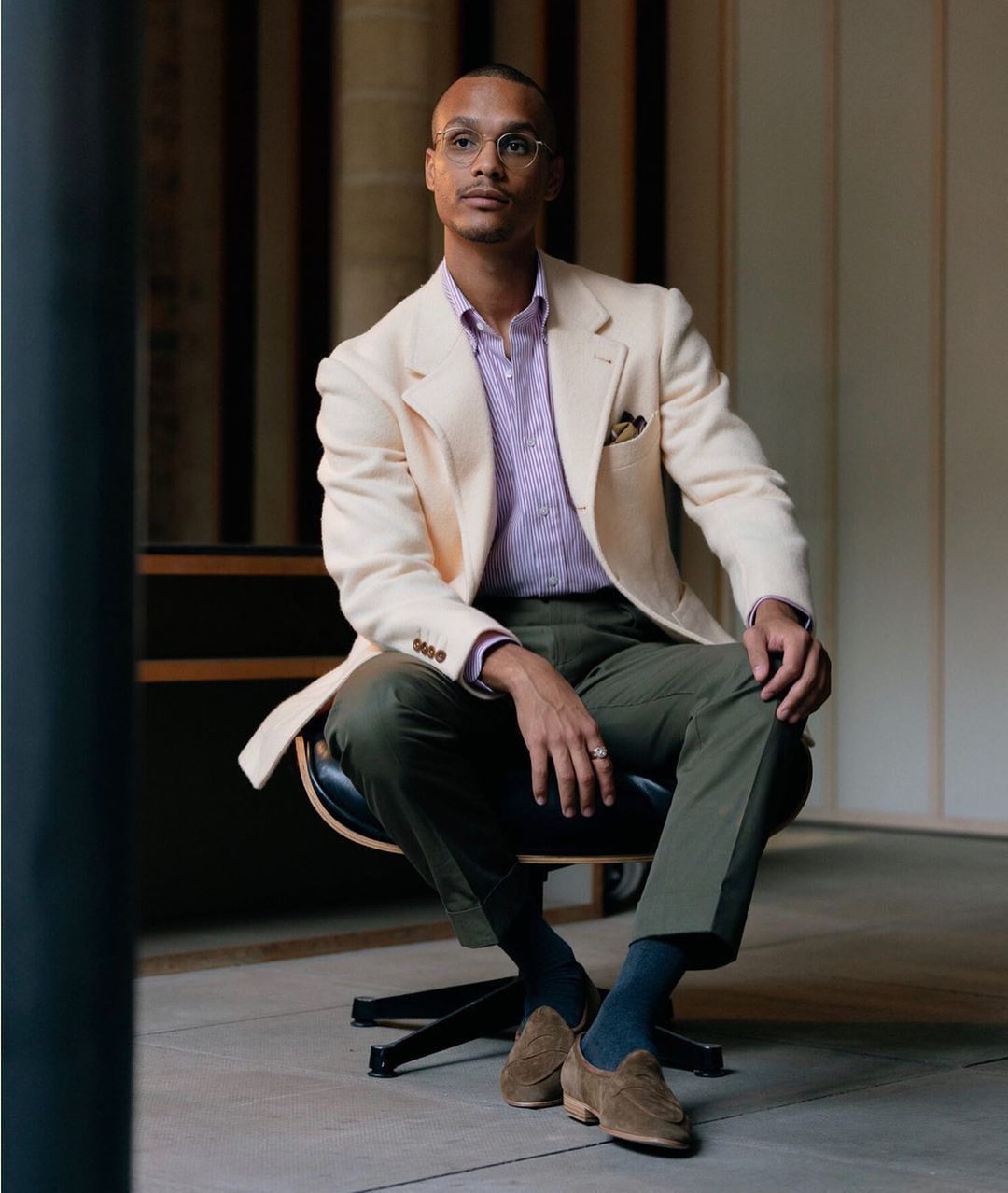
Manish wearing The Anthology's sport jacket in the Jamie Ferguson x The Anthology Harris Tweed; Fab Gorjian in a soft tweed from W. Bill; Jimi Williamson in the Anthology's "shaggy dog" jacket
BT: Exactly, 2020.
DH: That's a great jacket.
So how do you pick fabrics that fit your brand's identity, especially given that tweeds, which are not common today... people think of them as heavy, and itchy, but menswear enthusiasts... there's something about tweed...
BT: Interestingly, this is only one of a few tweed jackets. Whenever we launch tweeds, there's a very specific reason to it. We don't always do tweeds either. We actually still focus on... wool cashmere, wool silk linens, linens. If anything, linens are really part of us. It's our bread and butter—especially in Asia, because it's hot.
DH: Yeah. I think I featured you early on in my blog, in my article about dark brown linen, And I remember you had a dark brown linen double breasted suit with black buttons. And I remember reading the caption about the black buttons, and how you picked the black buttons for that suit.
BT: The mother of pearl buttons.
DH: ... and I always wanted a brown linen double breasted suit. I eventually ended up getting one, but yeah. Black buttons, that stood out to me. And it was a great cut, Obviously.
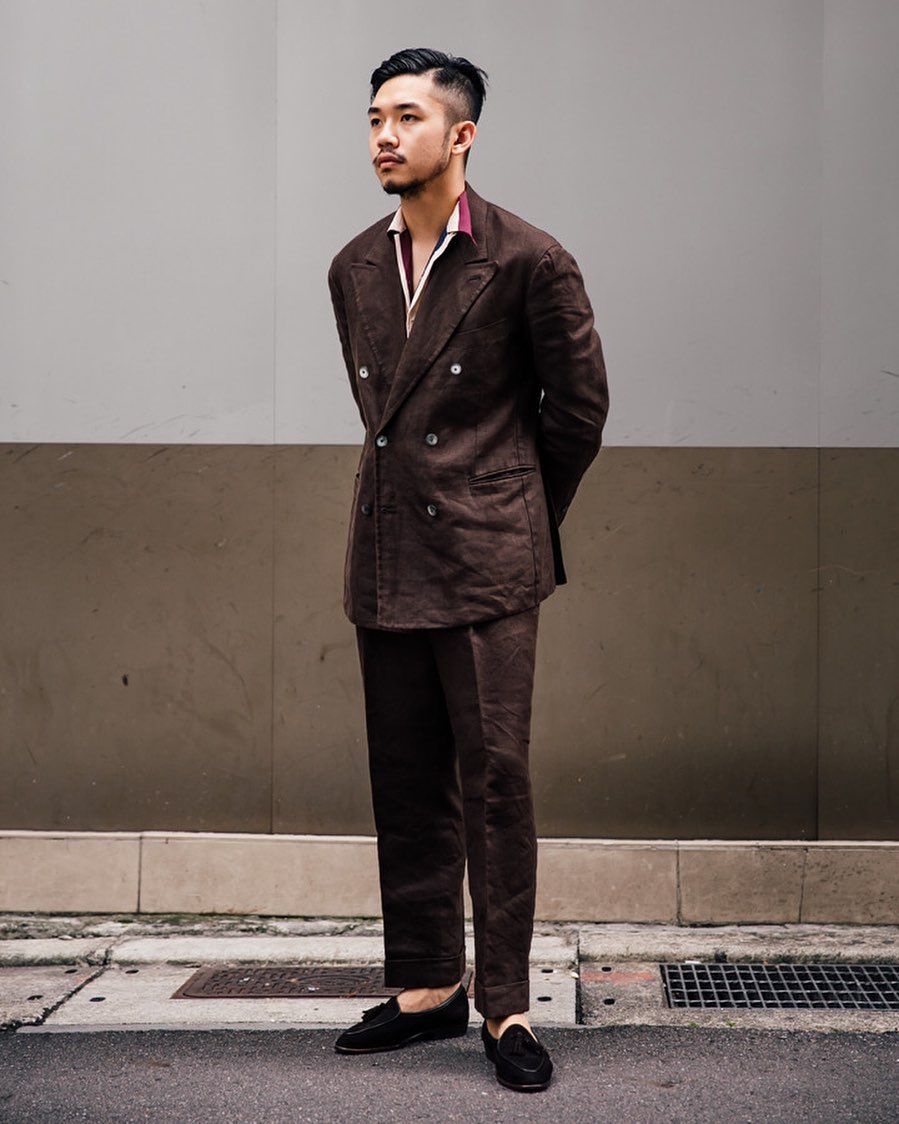
BT: Sometimes it's all about like putting a slight creative twist to it. At the end of the day, classic tailoring is just... a tailored garment. It's a garment that still has structured shoulders, lapels, collars, two pockets on the side... there's only so much you can actually work around with. So obviously within the very limited realm of things that we can actually play around with, we try to be as adventurous as we can, yet still making sense for everything that we're trying to do. We, we are constantly designing garments that could actually speak to both, without a better word to describe them, enthusiasts and "normal" consumers as well. Cause a lot of consumers cannot relate to, for example, getting a tweed jacket. So we must have something that would eventually work them. For example, our Lazyman jacket, which is the casual side of things. But It still says a lot about the brand identity, still carries that classic image. It just has a different approach.
DH: Right.
I would like to hear more about designing specific pieces. And specifically, the Knit T-shirt and the Lazyman jacket. First, the Knit t-shirt. It sort of took the world by storm—or, the menswear world by storm at least (laughs). The name... it's a knit t-shirt. Jersey is a knit. Every T-shirt is a knit, but it's a t-shirt that feels more like a sweater. It has that great ribbing... I think the ribbing and that dense sweateriness make it feel simultaneously like something you can wear with a blazer, and something that you can wear casually out the door the way you would wear a t-shirt. Would you be able to share any insight into how you designed it, or how you picked the colors? They're great colors.
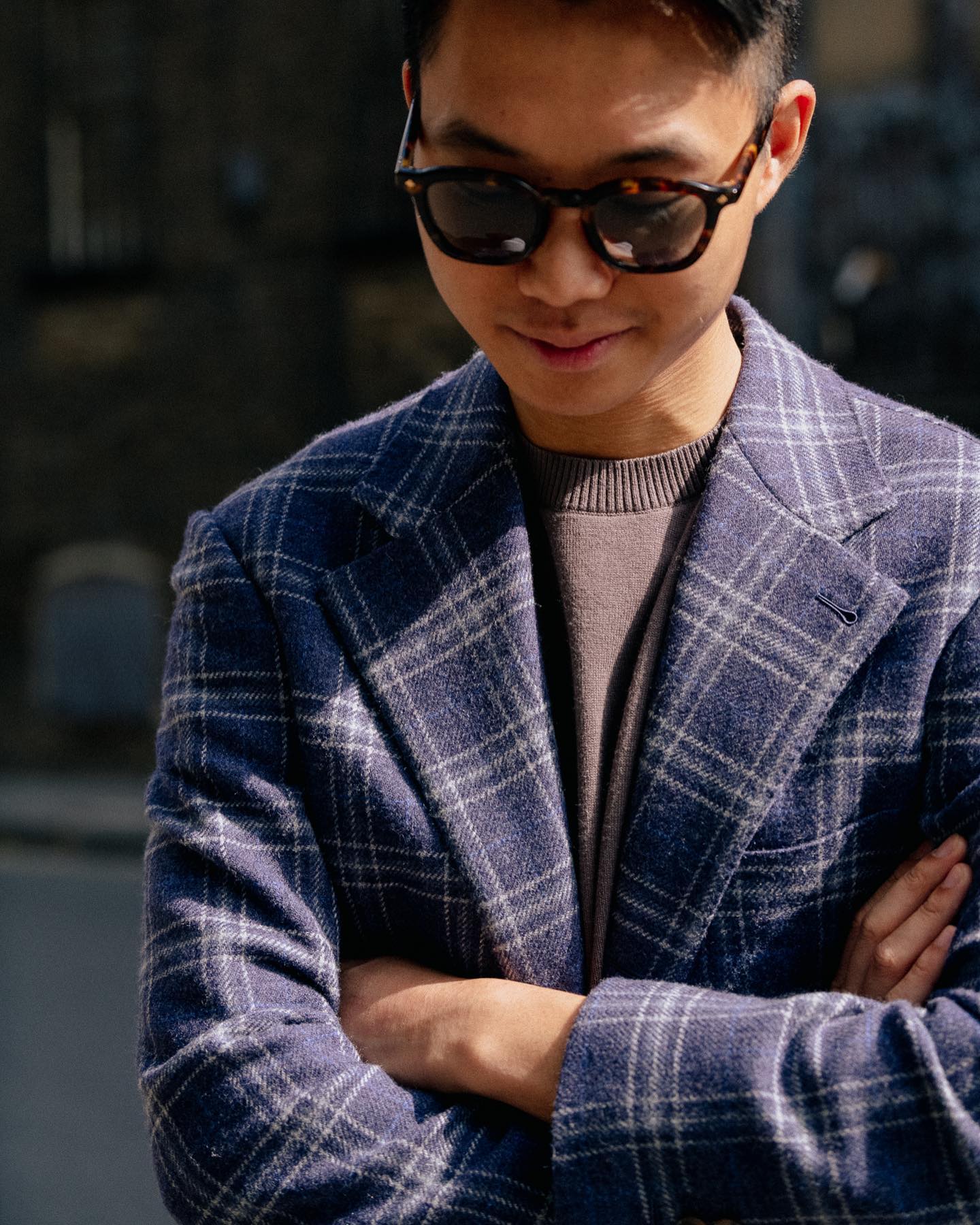
Buzz layering a knit t-shirt under a sport jacket.
BT: Interestingly, when we design things, we actually design as a whole team, like both (co-founder) Andy and I, and we consult our colleagues as well. Be it, Edward (who was there with us), or Casper and Willie from our talent team... So whenever we actually design things, we ask the whole team how they feel about it. These products, they don't necessarily speak to every one of us, but there would always be elements that speak to a specific one of us.
Every other classic menswear business actually has a polo shirt.
The knitted t-shirt's inspired by 1950s sort of sportswear. The shorter cut, the ribbing, this and that. We just want to do a modernized take on it, a very simple t-shirt that could actually work with tailoring because as modern times progress, a lot of people actually wear... especially summer jackets without wearing a shirt. Not even a linen shirt, these days. So in that sort of case, there's only so many things you can actually play around with. There's a polo shirt and there's a t-shirt. So we're like, okay, great. Polo shirt. Done. Sweet. Every other classic menswear business actually has a polo shirt. That's bog standard because it's easy to sell, and it's an essential piece that everyone thinks should exist. Which, we finally have one because we've kind of hit that point where we're like, "okay, you know, we've got the t-shirt, but we need something for the winter." And for the winter, you want something with color, so like great long sleeve polo shirt. There you go. But prior to that, we wanted something that has a very special identity that really differentiates us from any other menswear business, hence we had the idea of having a t-shirt that could fit into like a menswear/sartorial wardrobe. So that was our proposition. We actually made a lot of modifications to it, even deciding whether to have pockets or not. At the end of the day it's a simple exercise of like... elimination. Having this pockets, yeah, great, they look very vintagey, but is it exactly our thing? Not quite.
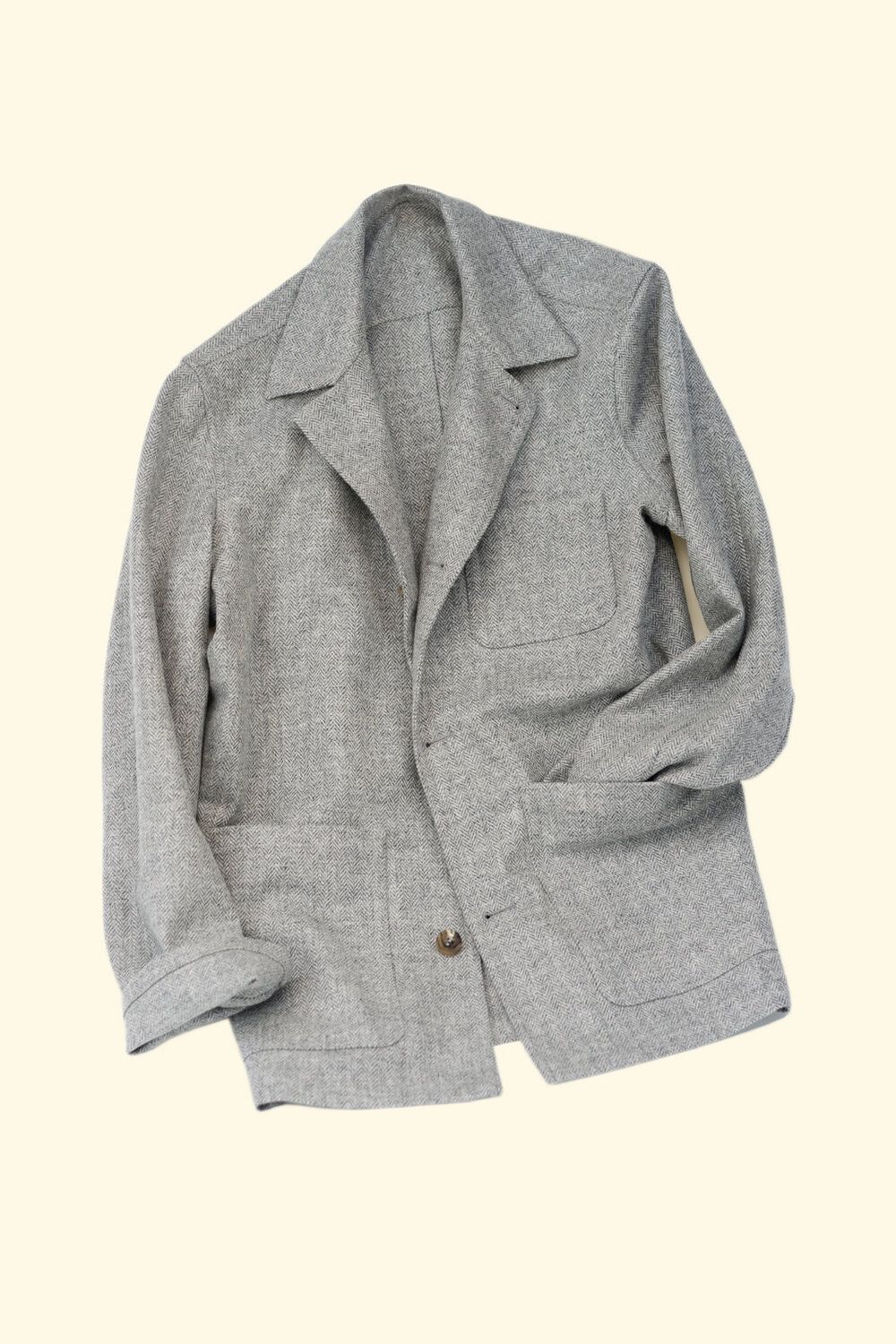
DH: All right! The Lazyman also stood out to me. And Teba jackets in general. They take elements of what makes what makes us love a blazer. But they're also very clearly, very visually, not quite a blazer. There's something casual. They have the straight hem, they have in your case the patch pockets. You know, the Teba jacket might have different lapels... it has the upsides of a lapelled jacket, of almost a blazer. It speaks to the menswear sensibility, but it's also something that I feel like I can throw on while I'm walking out the door, no matter what else I'm wearing, and just feel comfortable and not feel like I have to make an excuse for dressing up because it's not quite that.
BT: You got the jist. You could easily write up the article without my help, honestly. (We both laughed at this). No, thank you for taking the time.
I always want to dress in a sartorial manner, but my friends actually don't relate to it.
Yeah. I'm very fond of the Lazyman jacket. It speaks a lot about myself as well. I always want to dress in a sartorial manner, but my friends actually don't relate to it. It's really hard for them to like, when you're actually dining out with people, when you wear like a suit and tie... It's just feels really out of place. For example, if you actually go down to Brooklyn, unless you're like an art school kid, where you actually want to dress in a full aesthetic... it just doesn't make sense to wear a tie.
DH: Unless you're Ethan Wong.
BT: I guess so, yeah. Ethan Wong is a very strong individual. He's very interesting in his own way. But for myself, I live in a modern world as well. London is fast moving, like Hong Kong or New York. So in societies like these, I don't think a suit and tie is always appropriate. It has its own time and place.
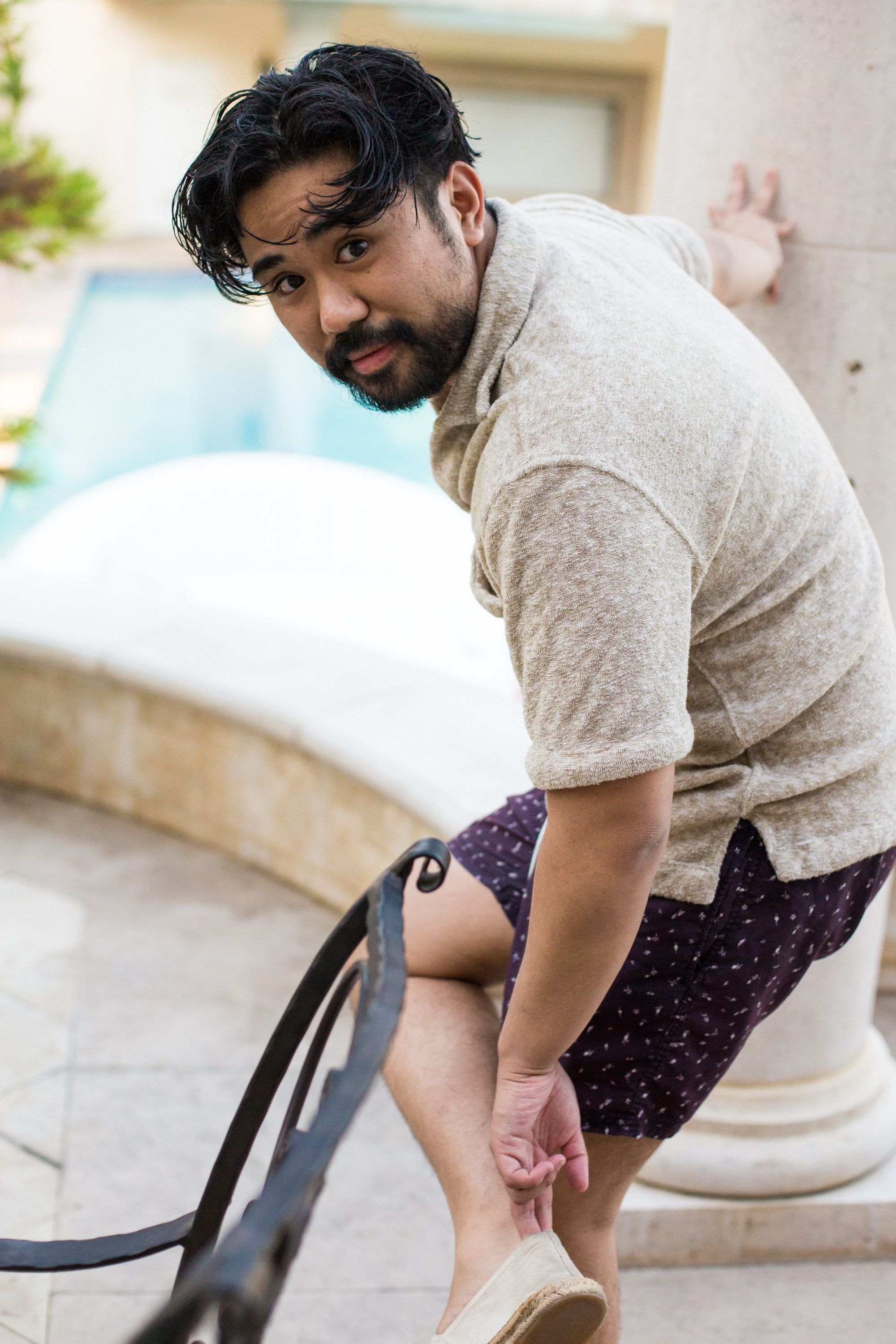
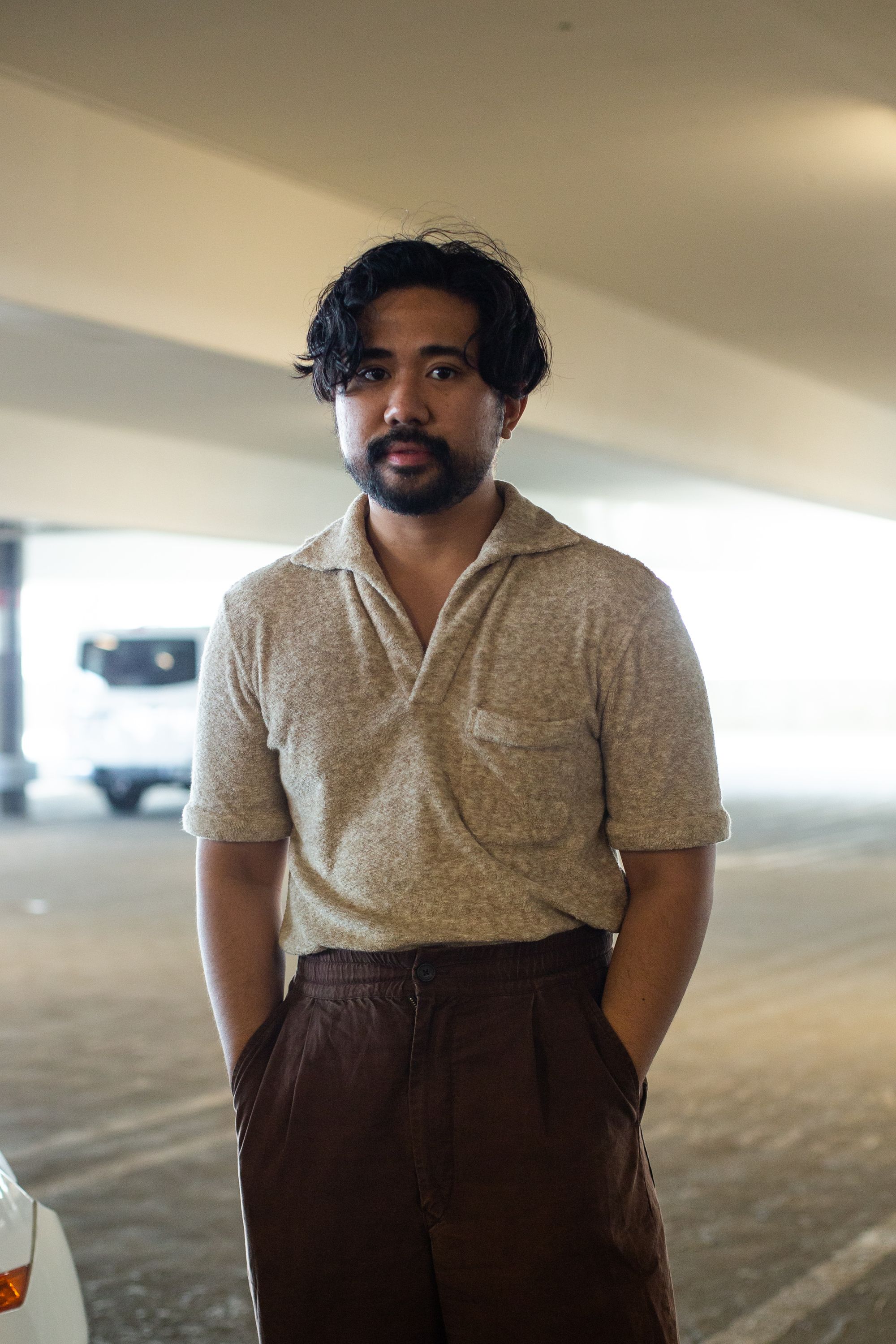
Ethan doesn't always wear a tie. Like, if he's going to go for a swim, he usually doesn't wear a tie. Here he is in The Anthology's Terry Popover in "Toy Poodle."
DH: I'm not wearing one now!
BT: Exactly. I'm wearing one because it's a special day for us. We're running a trunk show, so we're seeing clients who are actually a little more proper as well. It makes sense.
Back to the Lazyman jacket, I'm really fond of it. It's a garment that I'm really passionate about. We even had a joke about it. So... before we designed it, we always wanted to actually have a deconstructed jacket, which now we do, the featherweight blazer. We've only added canvas to a certain part of jacket to retain the lapel roll, yada, yada, yada. You can actually read it online. It's kind of, I don't wanna bombard you...
DH: Don't worry, I'm loving it.
BT: But the Lazyman jacket's basically a cardigan-jacket hybrid. That's our original idea. Andy and I always had this joke, you know, back in the days when... "Meta," when Facebook was still a thing, we were always like,
"classic menswear is going downhill. We have to design these garments that would suit Silicon Valley boys." So we're like, "okay, great. Maybe we should actually do something that still has like a collar and a lapel, but making sure that it doesn't look exactly like a jacket." So that was the original idea. So we wanted a loungey jacket that you actually wear at home, you can actually wear for Zoom meetings. Back when Zoom meetings weren't big yet.
DH: There are some details that deviate... First of all, I assume it was at least partly inspired by the Spanish Teba jacket.
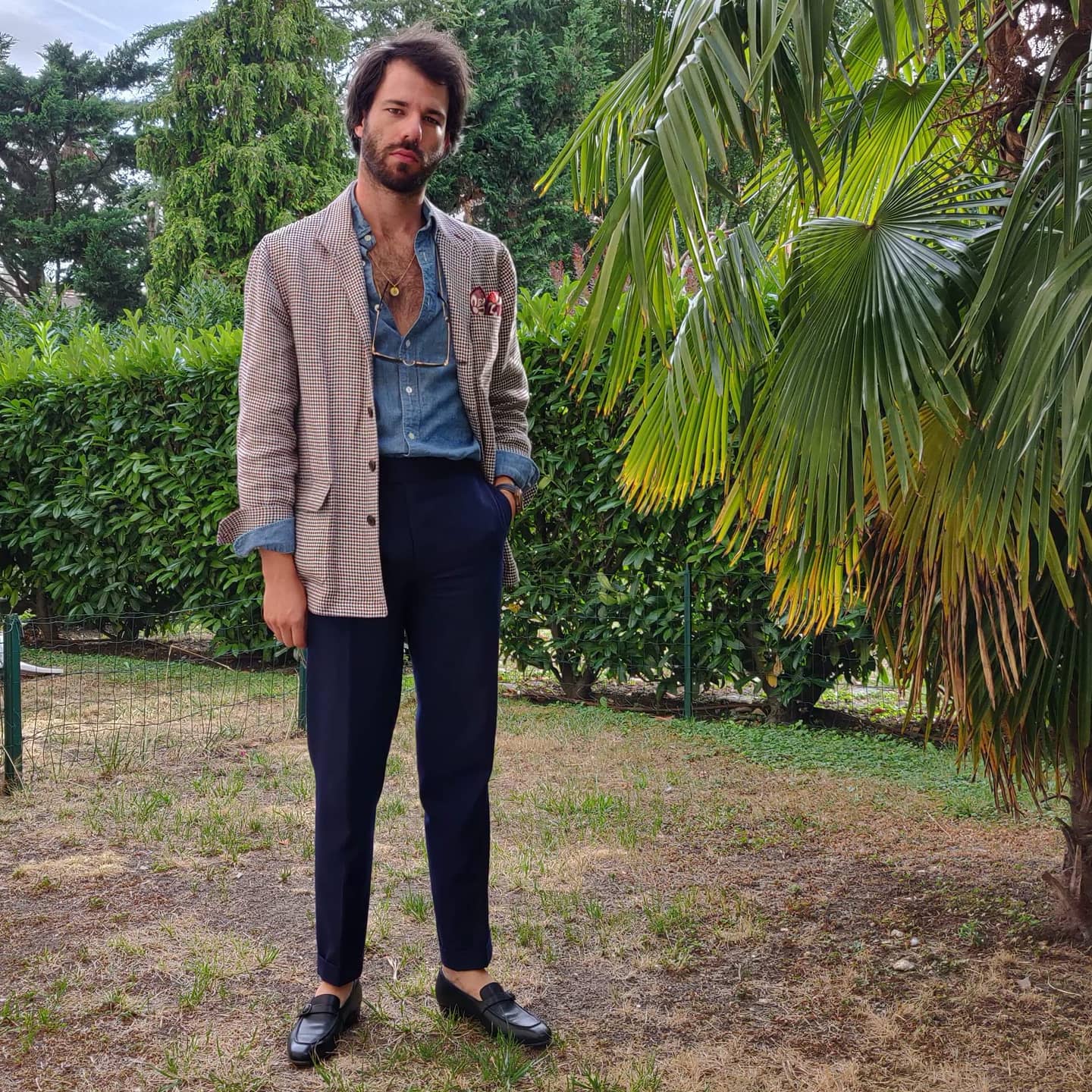
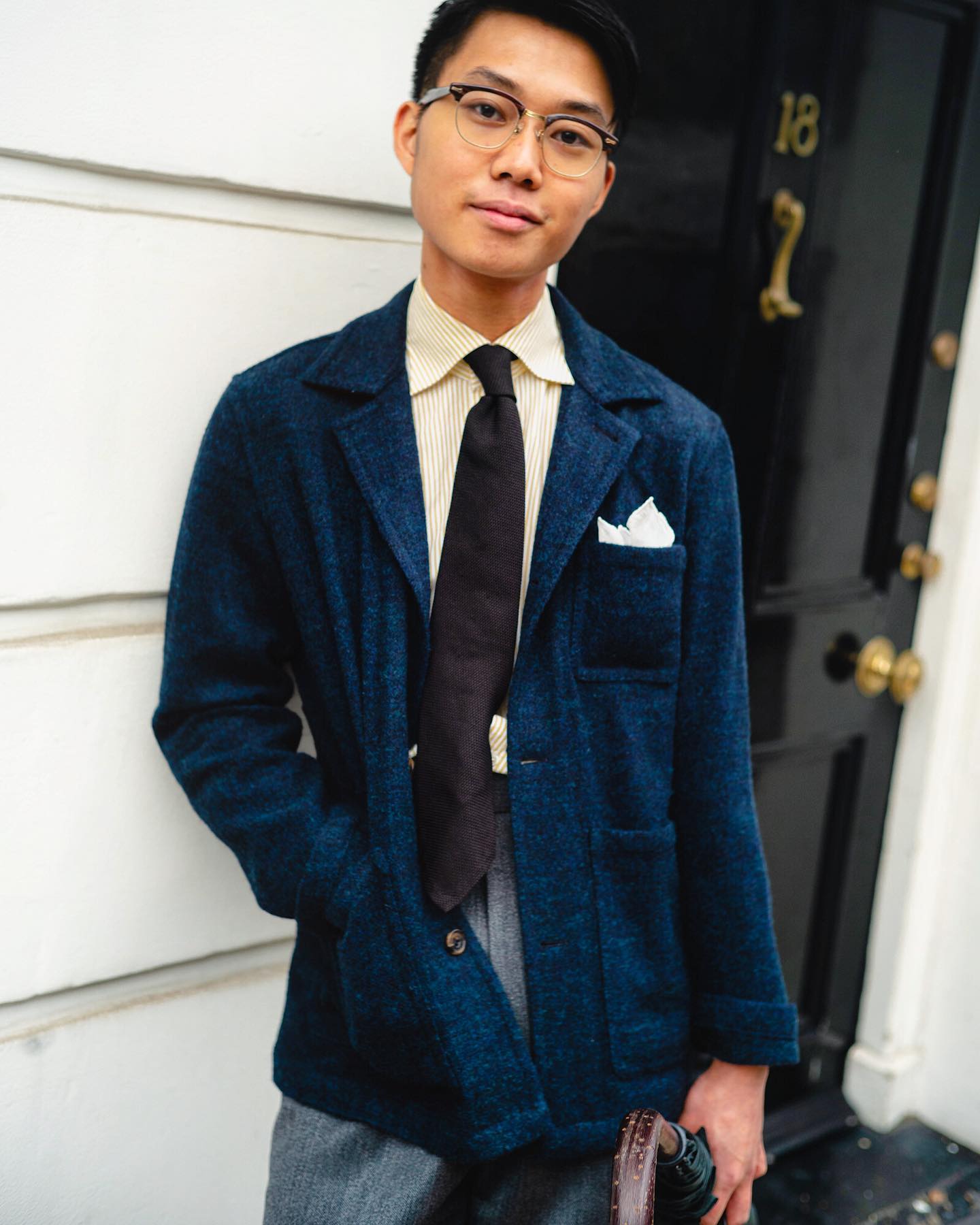
Left: A classic Spanish Teba jacket (not made by The Anthology). The platonic ideal of a Teba jacket involves a notchless lapel, three or four button closure, straight hem, three patch pockets with flaps, and a single button cuff. Right: Buzz in The Anthology's Navy/Teal Bouclé Lazyman Jacket, also with straight hems, but with a three-roll-two closure, three patch pockets without flaps, a notch-like lapel similar to a camp collar, and buttons on the back to tighten the jacket as needed. Both jackets are unstructured, both lapels roll high, and both jackets fill the roll of something blazer-adjacent but obviously more casual.
BT: Not quite, actually.
DH: Really? Just a coincidence? Maybe more of a chore coat that turned out...
BT: Actually, we were thinking of making chore coat. The chore coat was actually the closest thing we had in mind. The Teba jacket, I specifically did not want to reference because we're not a Spanish house.
DH: Fair enough. Yeah. But it is a little bit like a Teba jacket in that it has the the square hem...
BT: I can tell you a bigger coincidence as well. So, I like art to a moderate degree. Obviously I'm no guru, but I remember I was actually reading some books about a French artist, Jean Cocteau.It happened he actually had a jacket that was very similar to a Lazyman jacket, but I only found out a year after the Lazyman jacket came out. So I was really bummed out because I was like, "oh, if I knew earlier, I could have used Jean Cocteau as an inspiration and talked about it." But yeah, it came a bit late.
So yeah. Teba jackets. Yes, I do see certain resemblances, I see similarities. But when I was designing, to be very honest, I wasn't thinking of it. I do think the Teba jacket is not a thing that I could fully relate to. I do think I can admire, I can appreciate the structure of a Teba jacket, but for some reason I feel like there's a little bit of a, almost like a countryside or like hunting sensibility, a Teba jacket. Whereas the Lazyman jacket is definitely more like a city guy's approach to...
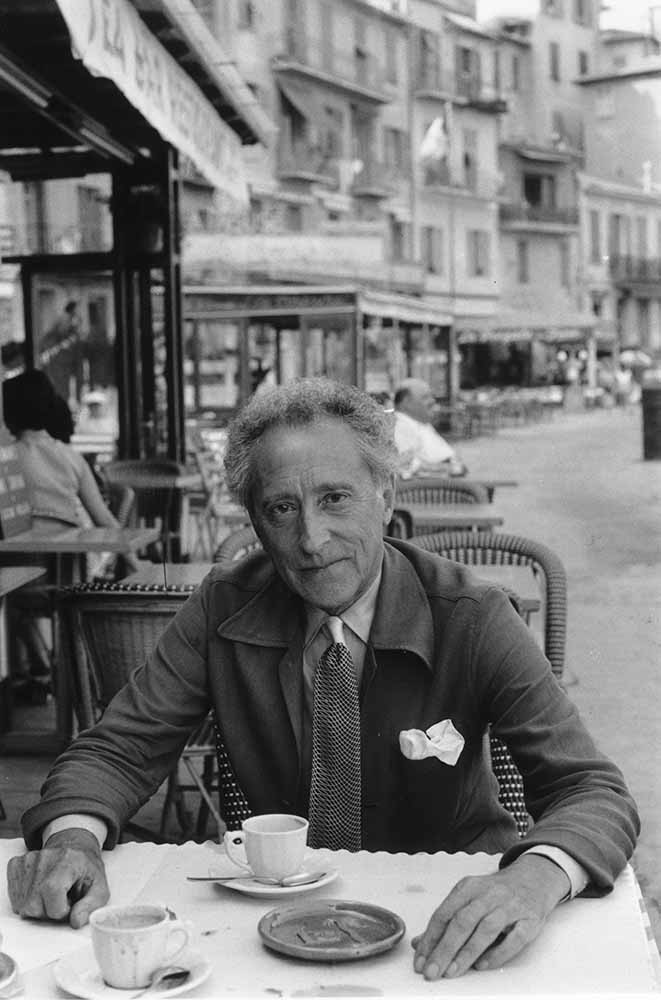
DH: Well (laughs), you know what the Armoury calls their...
BT: City Hunter. Oh yeah! Of course!
DH: Yeah.
BT: But I don't hunt in the city. No. I might, I might be hunting for cash, you know, I might be hunting for money, but no.
DH: It's more... something that you can throw on and go to a bodega, than go hunting.
So, you mentioned knit jackets. Or, cardigans, you said. Yeah. the, the Lazyman, you have it in a bouclé, in camel hair and in a lot of softer, fuzzier fabrics.
BT: It's the secret recipe to a Lazyman jacket. Every time we run development for a Lazyman jacket, where we do samples, where we're sourcing, there's a list of requirements of what we want to be implemented. For example, there was a while we actually started offering made-to-order for our customers, because obviously a lot of our customers have been buying a lot of our Lazyman jackets, and they're like, "oh, you know, I really wanted to actually use my own cloth, actually do something with you guys." Can we offer that? There's a very strong elimination process where we're like, "you cannot do this, you cannot do that. This is not available, that's not available."
(At this point, Buzz told me the only fabric they do make MTO Lazyman jackets in, but he wanted to keep this a secret.)
BT: ... But, for instance, linen is something that we wouldn't be using in a Lazyman jacket.
DH: Why exactly. Just doesn't feel right?
BT: It's part of our secret recipe. I guess to make it very easy, it's too crisp. It's almost a little denser, you know what I mean? So it's very different from a Lazyman jacket.
DH: Yeah. It's, it's dense and it's, it's linen can be heavy, whereas you, you want something you can kind of throw on and, and be cozy in.
Imagine it as a blanket.
BT: Imagine it as a blanket. I think that's probably the easiest way to describe it.
DH: I like that.
So, I don't want to talk too much about other brands, but a few brands like... Camoshita, recently, they've been doing knit blazers.
BT: Not aware of those. But (Yasuto) Kamoshita's (founder of Camoshita (no, that's not a typo)) a great guy. I've met him a couple of times. He's really nice. I have a lot of respect for him.
DH: He's a legend. So... I don't see too much knitwear from The Anthology, aside from the knit tee. I know you wear a lot of turtlenecks. Have you ever considered doing more knitwear? Maybe a knit jacket or knit knit Lazyman or something like that?
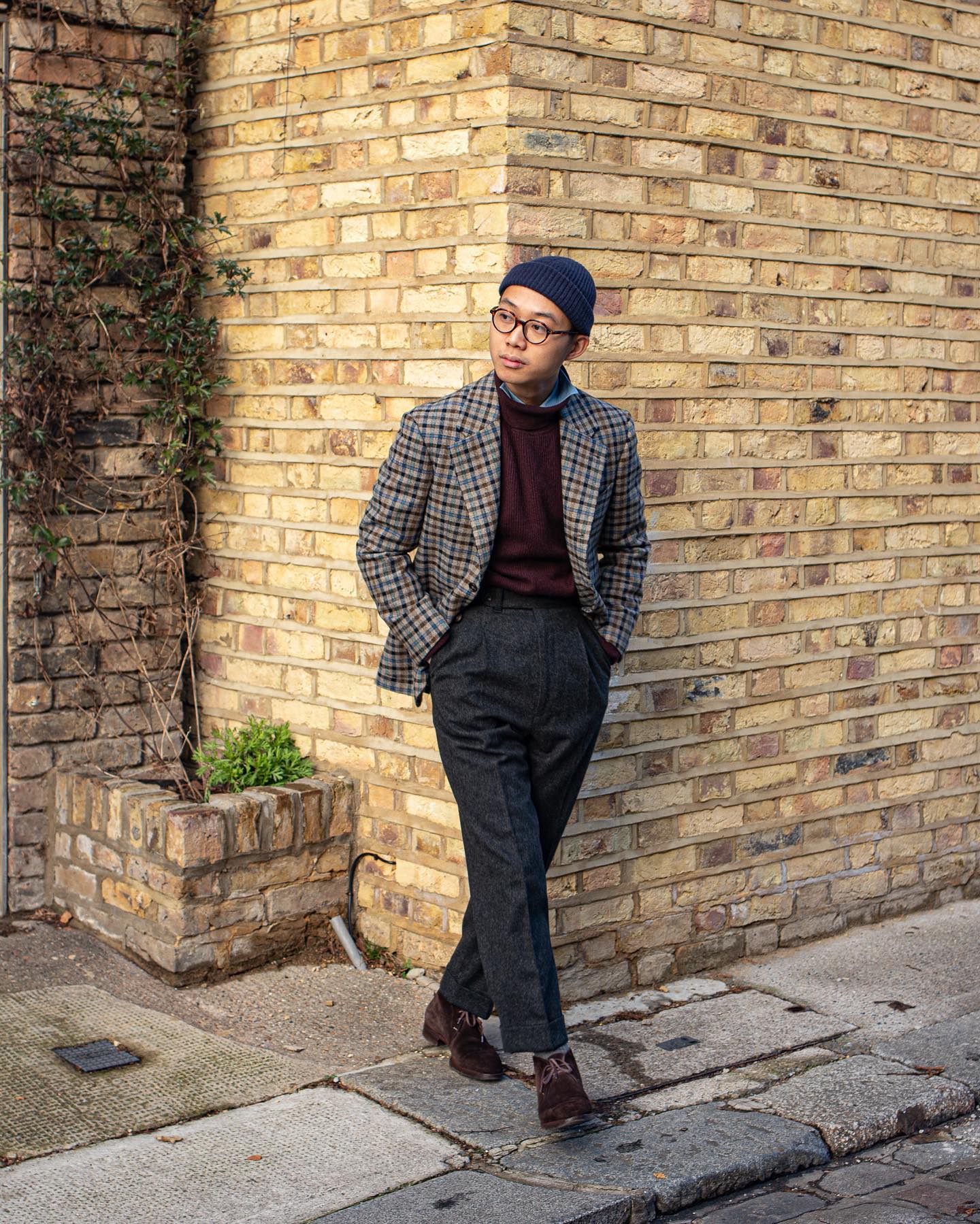
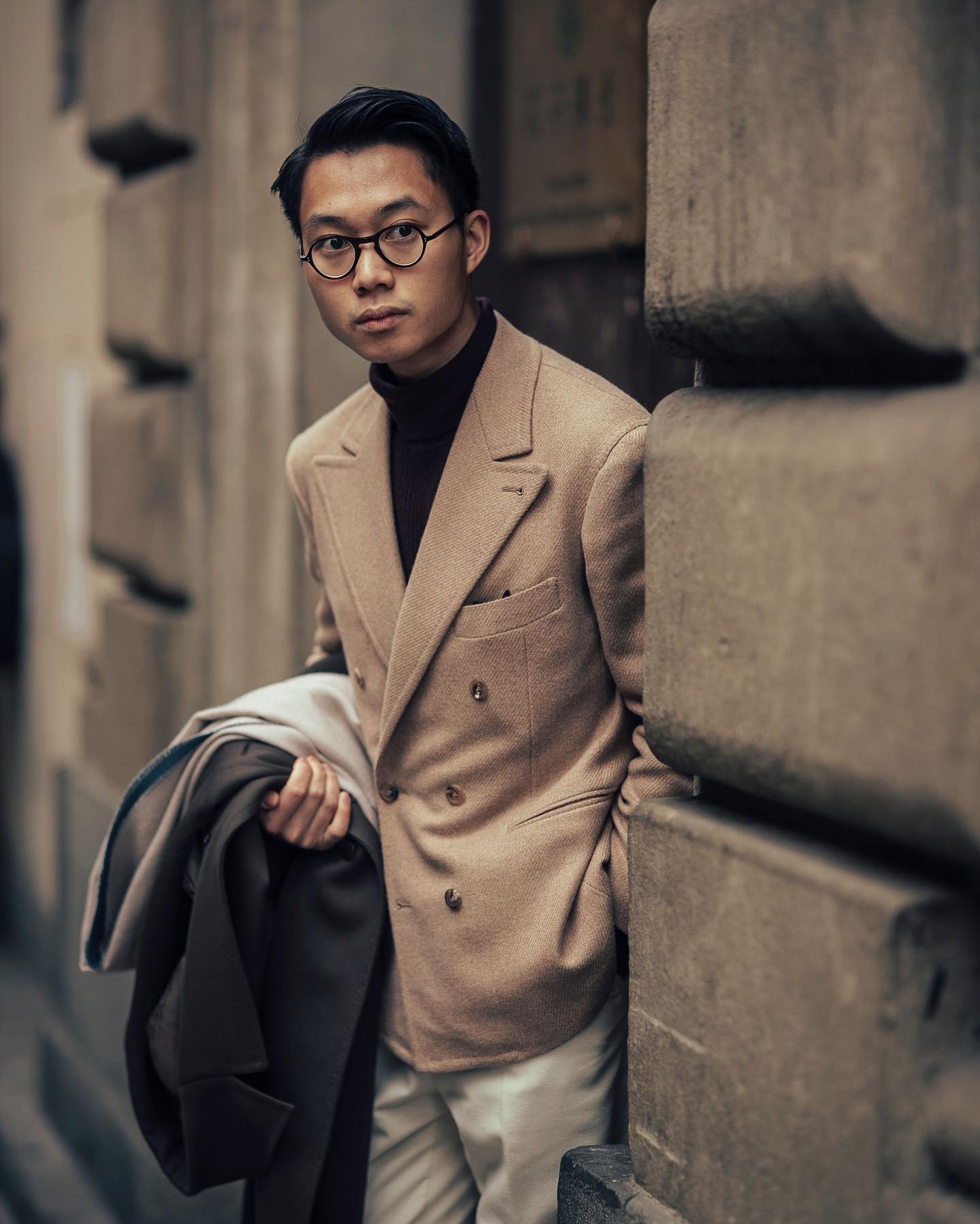
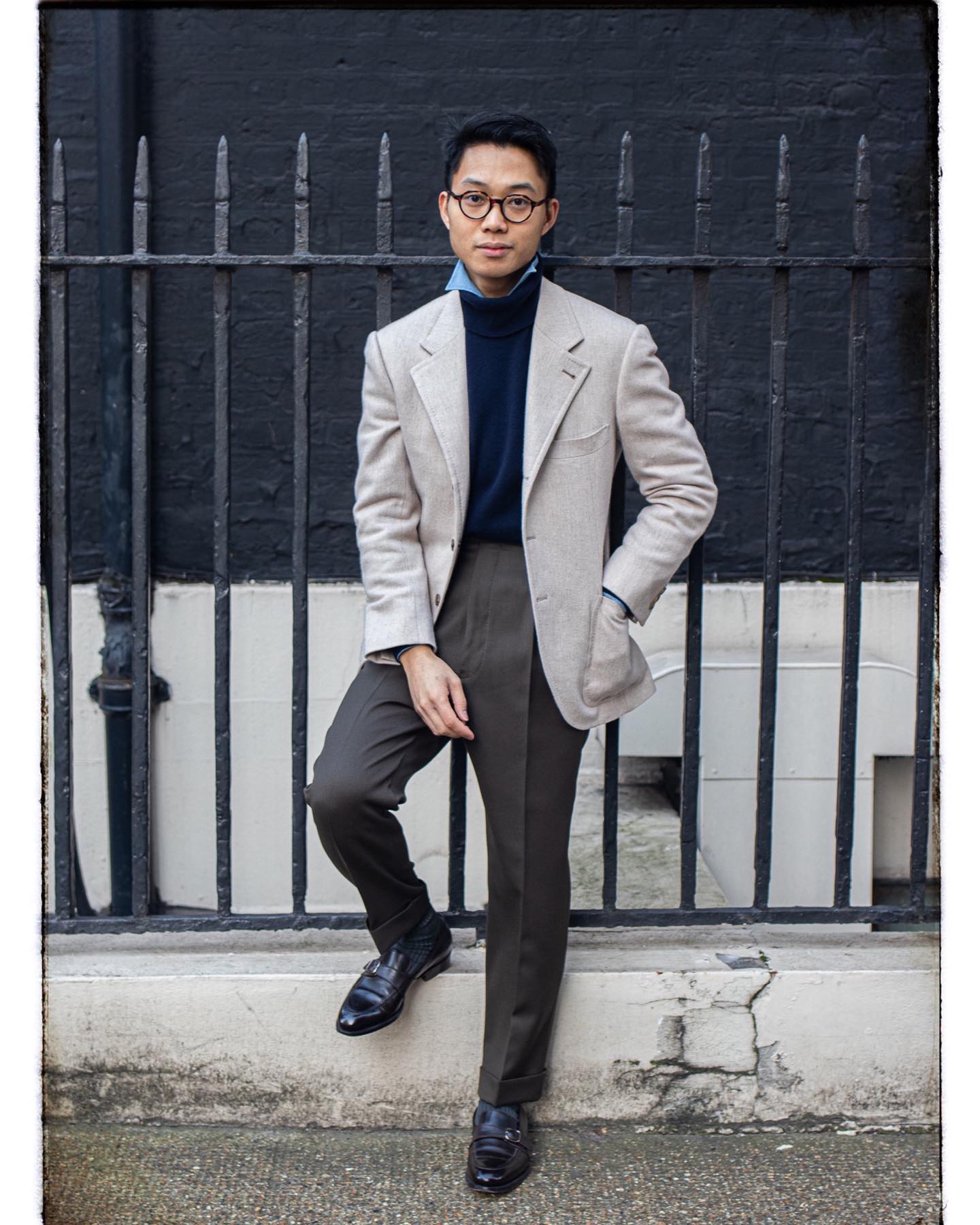
Buzz likes turtlenecks.
BT: The first day we arrived here, we were almost ashamed, because when we saw each other... I flew from London, they flew from Hong Kong. I came a little later. So by the time I got here, I saw them in turtlenecks. I was also wearing a rollneck, and I was like, "gosh, we oughtn't be doing something that similar, otherwise people would be complaining about it." All of our photos during winter, we're wearing these sorts of things, but we're not selling any of them.
So yes, we're working really hard towards a goal, but every development takes a lot of time. Almost a little bummed out. You know, I'm almost embarrassed to say that we still haven't had them ready, but they will eventually come. And it's been made official!
DH: Turtlenecks, specifically?
BT: I don't know what form. Can't promise now, but some kind of knitwear will eventually be coming around.
DH: That's good to know.
Can I ask where you get your turtlenecks and roll necks from?
BT: Mine? A lot of places actually. Cashmere manufacturers, like Johnstons of Elgin are great. I've also had a little bit of... branded stuff, actually, Previously obviously I bought a little from the Armoury. I don't know, a little bit from... let me think. I weirdly had some from Loro Piana, Brunello... I did have some from Prada as well. I'm a little bit of a fashion kid. Like, if you really wanted to delve into that, I was a fashion kid, so I like my fashion as well.
I'm a little bit of a fashion kid.
DH: I was gonna ask, do you think of yourself as a fashion designer?
BT: I would love to think that way, yeah. I think, because we're designing as a team, you know, I don't take full credit for my design. The design actually belongs, obviously, to all of us. But yeah, I would perceive myself or ourselves as like, a... partial fashion designer. Right. Mainly menswear designer because of where we are and what we do right now.
DH: Right. Maybe you're not the same as Alessandro Michele, but you're not not doing fashion. You're, you're not immune to trends even, even though you take inspiration from classic...
BT: Pretty much. Might be a little controversial, but, a lot of people say "style is not fashion," yada, yada, yada... I do think they share a lot in common, actually.
DH: Yeah. People like to imagine that they're immune to trends and that their taste just triumphs over anything that anybody else is doing. But we're all products of our environments. We all see things. If my friends are wearing something I'm gonna say, "oh, yeah, that's actually cool. I never realized that." So there, so there's something propagating over time. You can't just design anything in a vacuum. Even though there are timeless inspirations. And there are basic tastes that, you're a very tasteful guy, but...
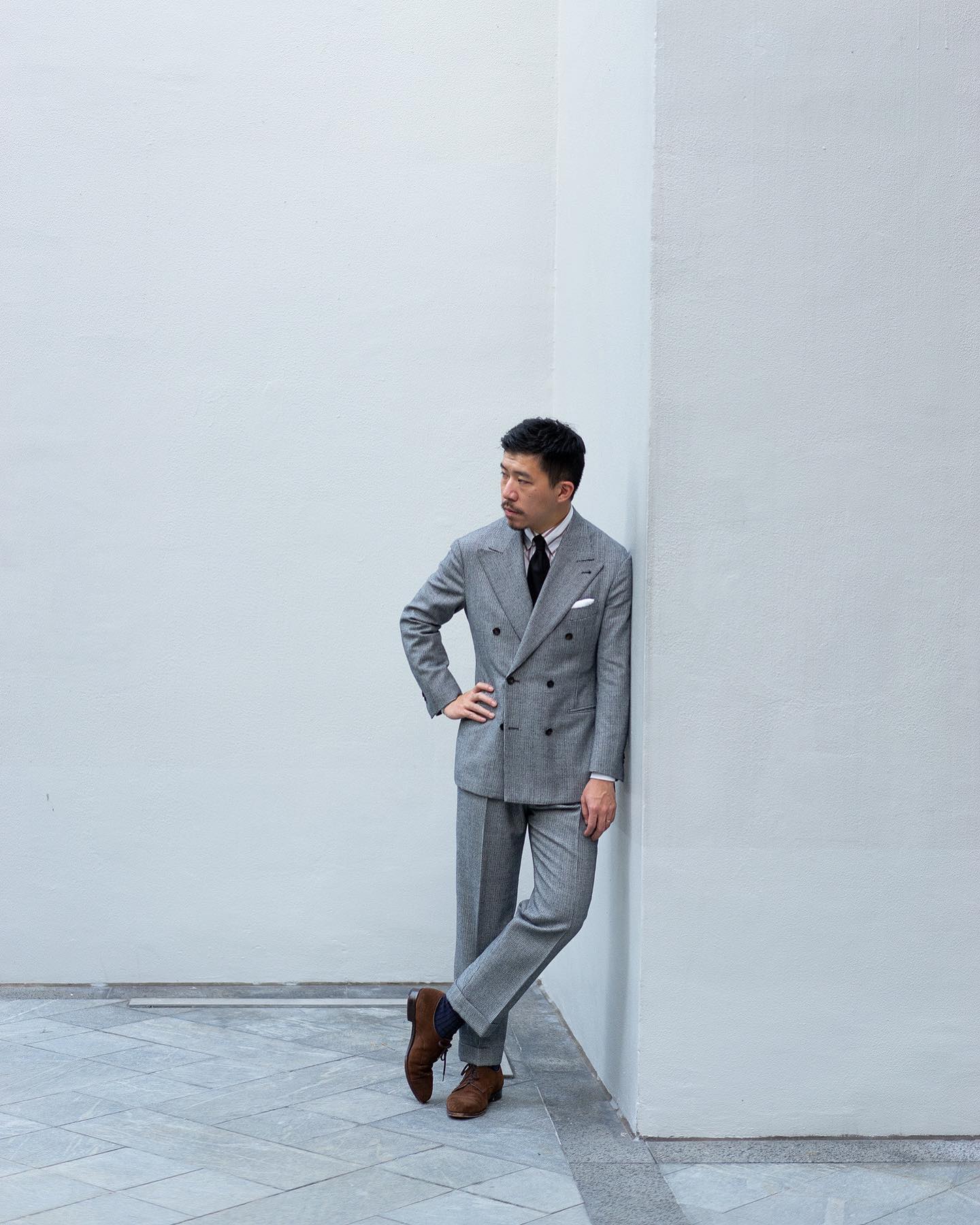
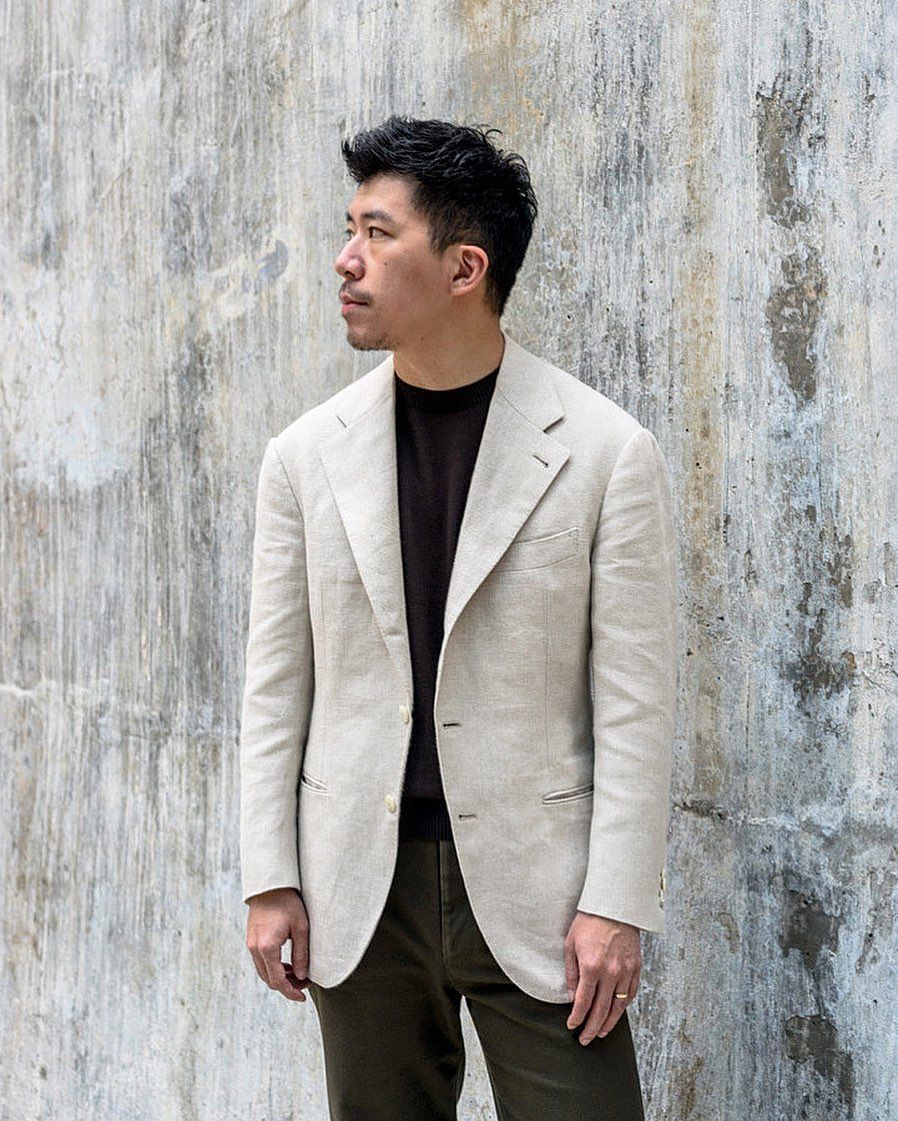
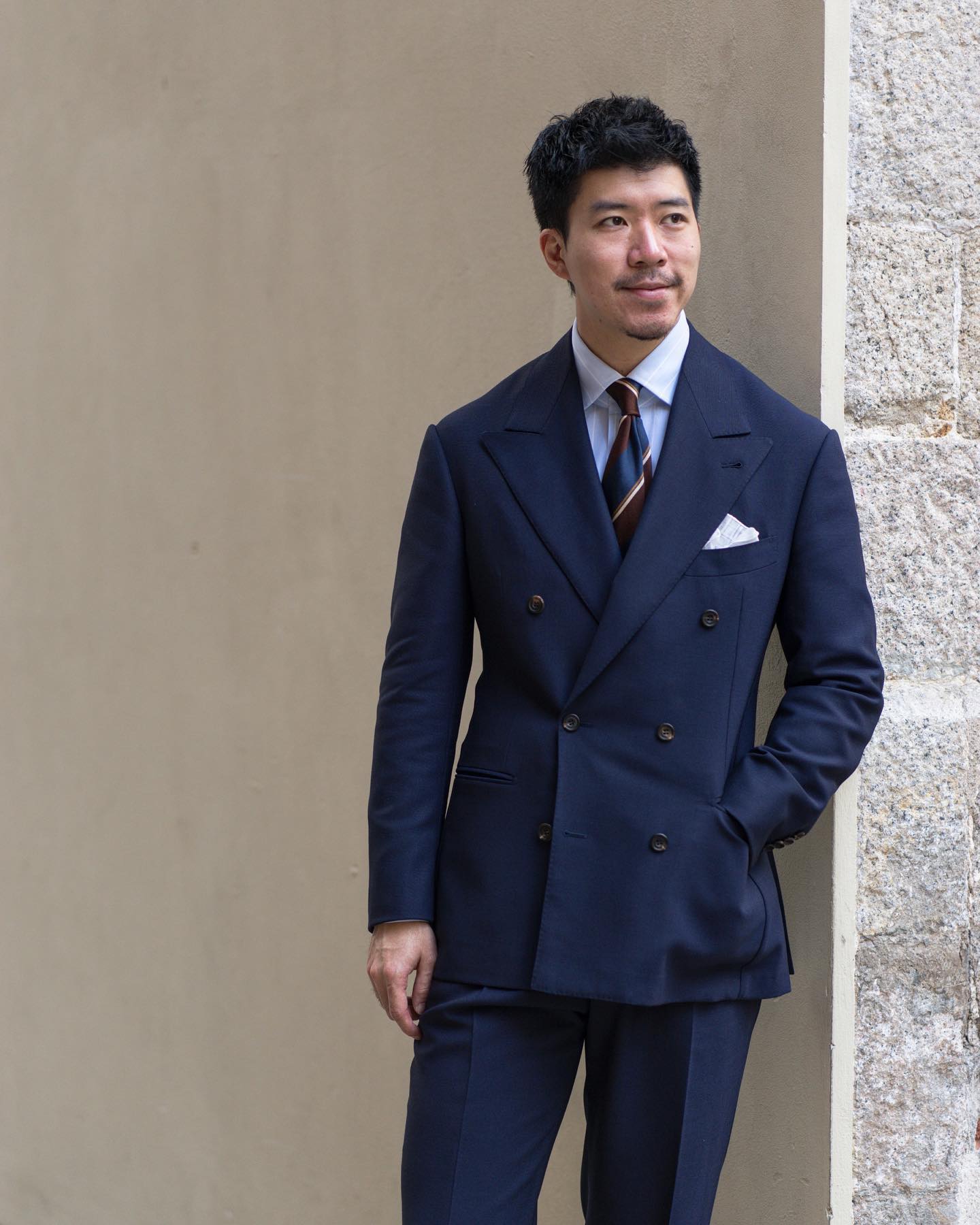
Some photos of Casper... Inserted here to break up the wall of text.
BT: You're too kind. But fashion is constantly about referencing, but there are also certain things that I actually don't enjoy about referencing as well. It's awful referencing, for example, things that carry strong military connotations, or things that are, this might be another controversial issue... a lot of these designs came from like military designs. Is that a good or bad thing? I am not sure.
DH: It's a hard thing to avoid in menswear.
BT: Exactly. But I also think it's something that we're actively trying to avoid. As a very sensible, modern person. I'm very sensitive about anything that's borderline culturally appropriative. Or Military related. You know, even when we talk about field jackets, obviously every other menswear brand would have a field jackets, a Safari jacket... "Safari," itself, as a name, it's almost colonizing.
DH: Yeah...
BT: If you know what I mean. This could be off the record, but...
DH: No, I hear you.
BT: It's not exactly my favorite thing to say. And even field jackets, when you have like all these functional pockets. I get it. You know, I had this conversation with another writer some time ago. I think field jackets and Safari jackets are still acceptable. You know, there's functional pockets and you actually don't fully advocate for that military image, it's still fine. But ghurkas, I've always found really interesting. They were army trousers. They were Vietnamese army trousers, and they were worn at mankind's very worst hour in wartime history. Why would someone... I get it, back in the day, in, like, the sixties, seventies when students were kind of broke, they had to go thrift for these Ghurka trousers. I get it. Because back then it was the lack of resources and money that led you to thrifting. But right now, when you have ample resources, as a fashion consumer, you're spending hundreds of dollars on these types of products. Why are we recreating pieces that don't necessarily elaborate on the best idea of mankind?
Why are we recreating pieces that don't necessarily elaborate on the best idea of mankind?
DH: I think that's really a good perspective. Not to knock, there are brands that make beautiful military-style pieces, and that draw great inspiration from that. And I'm not trying to disrespect those brands, but that's a really great perspective for your brand to have. And it sort of reflects...
BT: There's a huge gray area as well.
DH: Yeah. People talk about stolen valor, also. And people who were actually in the military have an attachment to that, that we, at least I, I've never been in the military. You know, I don't even wear a lot of workwear because it doesn't feel authentic to me.
BT: I'm on the same page as you are.
DH: Yeah. So finding something authentic to me is not about referencing milsurp, or workwear, or things that other people wear. And to some extent... I do have denim. I do have a chore coat. But to some extent, I'm looking for something a little different.
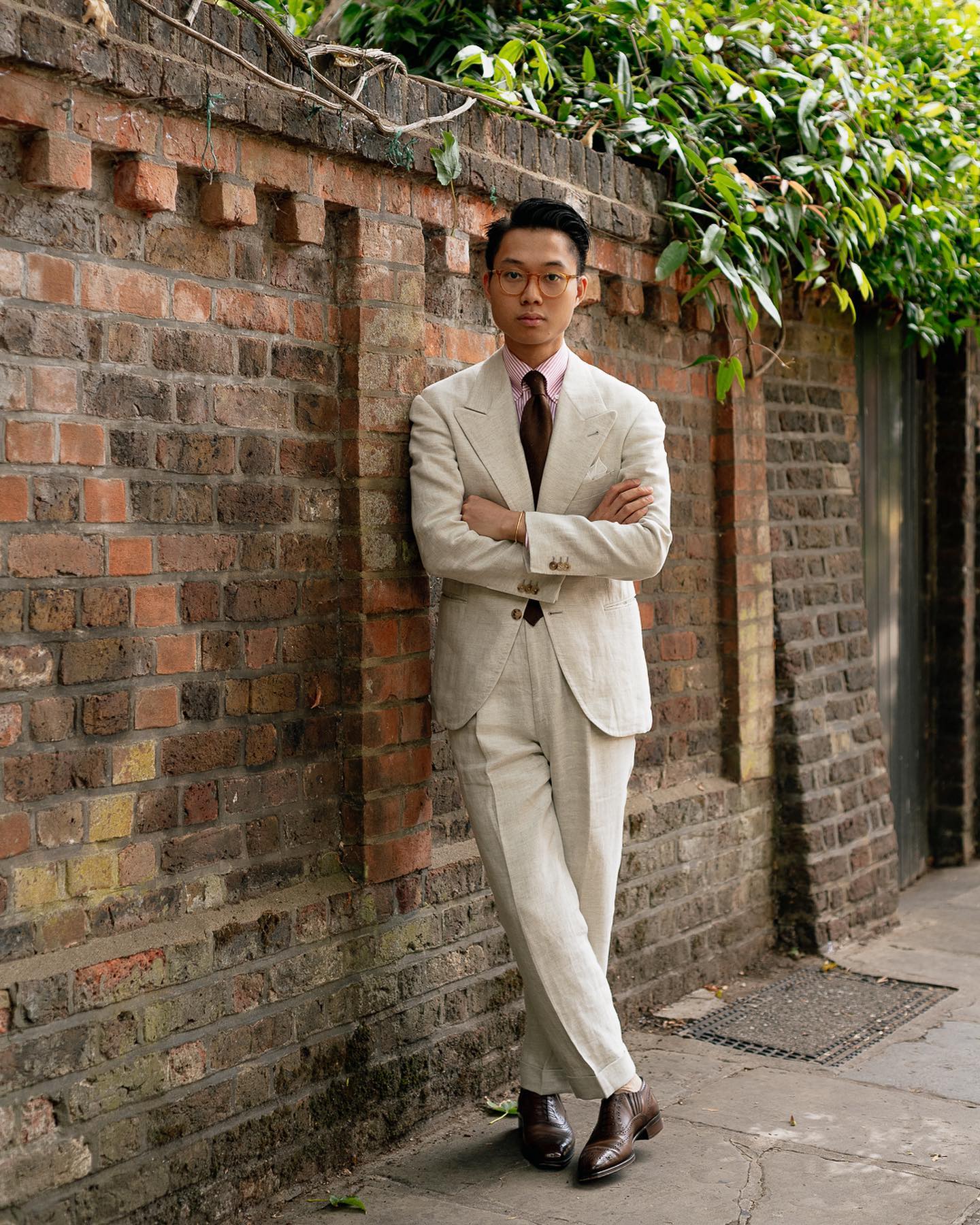
Buzz in a single breasted suit with a peak lapel.
So, we touched on this earlier, but there are things that you won't do for some customers. Like with the Lazymen. How do you draw a balance between being a custom clothing brand and having your own specific vision where you say "this is what works. This doesn't. I'm sorry. We won't do that for you."
BT: That's a brilliant question. It's a really hard line to follow. There are things that... you have to constantly say no to people, while, obviously, it's an operating business at the end of the day. There are certain things you kind of have to budge on, as well. Things there we don't allow people to do... Prior to us having a single breasted peak lapel suit or jacket, there were people who were like, "you know, I love Tom Ford's style. I love the five button design. Can you do this? Can you follow this and that?" When people bring in a Liverano and Liverano photo, they have a printout of a Tom Ford suit they bring in, they tell you...
DH: (laughing) They just want you to copy it, huh?
BT: Exactly. Hong Kong has always been notorious with tailors who are super efficient, super cheap, and just copycats, but nothing else. As creatives, these are things that we're really against, would really be a hard no, because it's not part of us, and we don't want any of these garments to leak out and for people to know that we're the wishy-washy kind. Because our image has always been jeopardized by part of the market. And now we're perceiving ourselves as an international label, but at the end of the day, because of our origin, a lot of people are still like, "these guys are from Hong Kong." And when they actually had such connotation we'd have to go an extra mile to make things right.
So these are the times that would give people like a hard no. But, for example... in the bespoke world, sometimes you have to adapt to customers' lifestyles as well. As a very simple example. You might have actually read our latest feature on Bill Nighy. A very famous British actor. He's a very nice gentleman. He's lived very well in his own Saville Row suits. So when, when Andy was conducting the spec fittings with him, he specifically asked for a longer jacket. It was very long to a point where like, that doesn't look quite like an anthology jacket. In some ways. So, these are things that we have to budge on. We have to... negotiate, going through rounds and rounds of discussion to reach an outcome. So there are certain things that we still have to accommodate. Things that we don't necessarily like, we still have to suck it up.

DH: It makes sense. It's just great to have an artistic vision that is strong enough that, if somebody's offering you a few thousand dollars to do something,you can say no.
BT: There are times that we still have to kindly turn them down. Very simple example, say someone's looking for a very powerful, edgy suit, say a very (Edward) Sexton-esque sort of thing. We, especially in London, we actually refer... there are a couple of names that we always refer them to. So we don't necessarily get the business sometimes, but it is part of the deal. We'd rather lose on these small gains, but catch a big fish, which is our overarching aesthetic approach in grand scheme of things. I think in conclusion what we had in mind was, as long as it doesn't deviate too much from our house aesthetics, it should be okay.
DH: So, you are an international brand. Especially in London, you refer people to different tailors. What's the difference between different customers around the world in London, New York, California, Hong Kong—any patterns that you've noticed?
BT: Well, we're still quite new to New York, to be honest. We have two stores. One in Hong Kong, one in Taipei.
Hong Kong was, or maybe it still is, a very strong financial hub. So the typical bankers will come in for navys and grays, that sort of thing. The occasional younger generation, kids with a little bit of money, they would get sport jackets and like a lot more interesting stuff. So we are very lucky to have cultivated a cohort of very friendly diehards who are very good friends of ours, very young as well, who are very into the culture, but want a little bit of that modern twist. That's where The Anthology kicks in. So that's Hong Kong. A lot of lawyers, barristers, attorneys like yourself—we don't use that word in Hong Kong, but it's the same thing.
In London, again, a lot of KCs or QCs (basically meaning lawyers, barristers). We have a lot of those clients. Very well educated, well-versed, very cultured in general. We have bankers as well, but obviously because we're operating on a trunk share basis for people who would actually join trunk shows at a young day, they are enthusiasts, to an extent. Otherwise they wouldn't even have heard of us. We're, we are still a very small company at a young day. New York... I would say London is very refined in the sense that I feel like a lot of our clients have experienced bespoke tailoring in the past, hence I feel like they know exactly what they're looking for in terms of fit, meaning that they come in, they leave it in our good hands, but you also know they understand why they're coming here and what they're looking for.
Whereas in New York, I feel like... this is really our second trunk show. So it's very hard to say because we were still at an early stage. But yeah, my understanding of New York is, clients actually... they love to get garments to wear. They really wear the shit out of it. So that's what New York clients are. They commission garments, they're like, "I want this, I want that, "I want this for like a specific occasion, I want this for a specific and event." So I think it's more like a styling game, rather than just tailoring. Obviously it has to come hit a certain standard, in terms of fit and everything, which is Andy's forte. So we have that covered, and the rest of it is really fun for me because I can explore different things with customers. Whereas in London, I feel like it's more... conservative is definitely the wrong word to use, but definitely a little more classic. Like, people are looking for very classic things. That are inspired by, I don't know, the royal family, traditional... money, wealth...
DH: Heritage.
BT: Heritage. There we go. Thank you.
DH: Okay. one more question. This one comes from Ethan (Wong), actually.
BT: Oh. Oh! Is that for me, specifically?
DH: Don't get too excited because it was kind of a joke. How do you come up with the social media copy?
BT: ... about the Anthology? Really? (turning to the rest of the team in the other room) Guys, how do we come up with social media copy? ... Intuition?
DH: Intuition.
BT: You get drunk, and then... Not really. We're not drinkers. Ethan would know. I am technically allergic to alcohol. I only started drinking maybe a year ago. But I'm not heavy drinker at all, we seldom drink.
DH: It's overrated. I mean, it, it's fun in college, you know, you stop caring about things.
BT: If you like drinking, you like drinking. To each their own, I'm not the police, I don't care. But how do we come up with social copy? Well... It's just ideas. You speak your mind. Sometimes we even question ourselves, are we actually losing a certain level of authenticity as a brand as we grow bigger. And it's concerning, because you feel like your creative ideas are actually being defeated by multiple elements, multiple facets, and as a friend, I would always hope that people speak up for us, share our posts, talk to people about what we do. Very kind of you, writing the blog, talking to these people, obviously any digital footprint helps the brand as well. So I genuinely appreciate your time coming over for us as well.
DH: It's really my pleasure.
BT: And... we really don't wanna just rest on our laurels. I would take that as a compliment, from Ethan or you or anyone else. The creative identity is in us. Some people... I don't want to sound disrespectful to any of the tailors out there, but there are definitely tailors who only know how to make clothes, but have no idea what they're actually serving. No idea what sort of value they're actually offering to today's world. But maybe because we actually see tailoring in a very different perspective. We see tailoring, apart from making the best clothing we can... it's also about creating a new cultural phenomenon. Like we want to change the world in the way we can. Hopefully for the better, but not worse. So... how do we create social copy? It's just speaking our minds freely. Which is exactly the way Ethan would do it, as well.
DH: It absolutely is.
Sorry, you reminded me of one last question. This might be silly. How much market research do you do?
BT: Market research. In what terms? Like look at what other people are doing.
DH: Look at what is trending with consumers, what consumers are gonna wanna spend money on...
BT: Ah, okay. So you've heard a lot about trend forecasting. Yeah. I studied fashion as well. So obviously, we were told to do this and that. You have to be on it, see what's happening. Upcoming seasons. As a classic menswear business—obviously we're... half classic, half modern, but still classic at the end of the day. In some ways, trend forecasting is bullshit to us, because our things are very seasonless, first of all. Like we wouldn't say "oh, a high street brand or luxury brand out there is doing this, and that's why we have to do this." Obviously the blouson was, is designed without putting in any sort of like, consideration as such. Do we do market research? Yes, of course.
I'd rather look at... Louis Viton, Bottega Venetta... Prada... Zimmerman, The Row... Even Visvim.
We care about what people are doing. Not necessarily other classic menswear businesses. I'd rather look at... big brands, even Louis Viton, Bottega Venetta. I actually like Prada, womenswear brands, Zimerman, The Row, I look at multiple things. We love fashion. Even Visvim. There's so many different things that we can actually look at. Market research as a whole... It just seems like... you'd be looking at competitive brands, brands that are higher than you, lower than you... Our way of running the market research is... Obviously it's statistics-based as well. From the e-com side of our team. We actually look into it. If you talk about, from the design perspective, or product-wise, we just look into things that we think would actually work well for us, and we would always look out for the right talents, the right people to actually be involved in the process. I don't tend to overcomplicate things. I overthink a lot—don't get me wrong, I'm an overthinker for sure—but I don't overcomplicate market research.
DH: That's good answer. Thank you. This has been fantastic.

